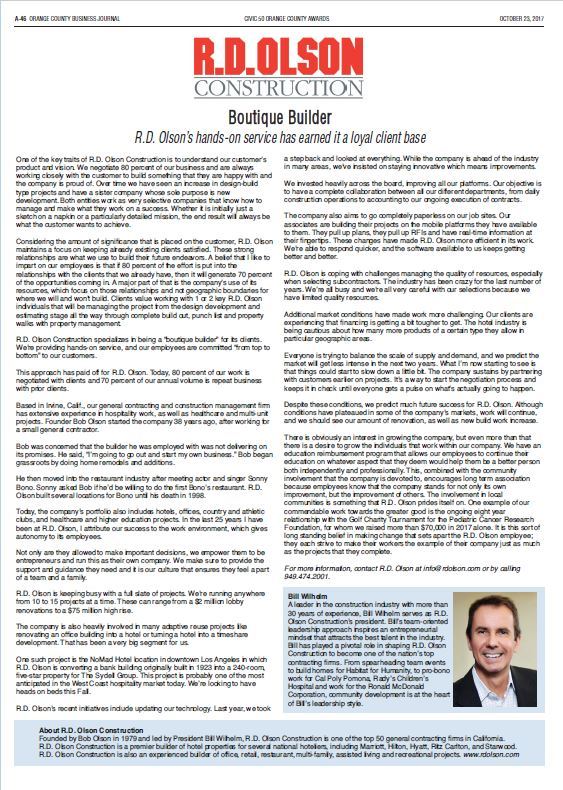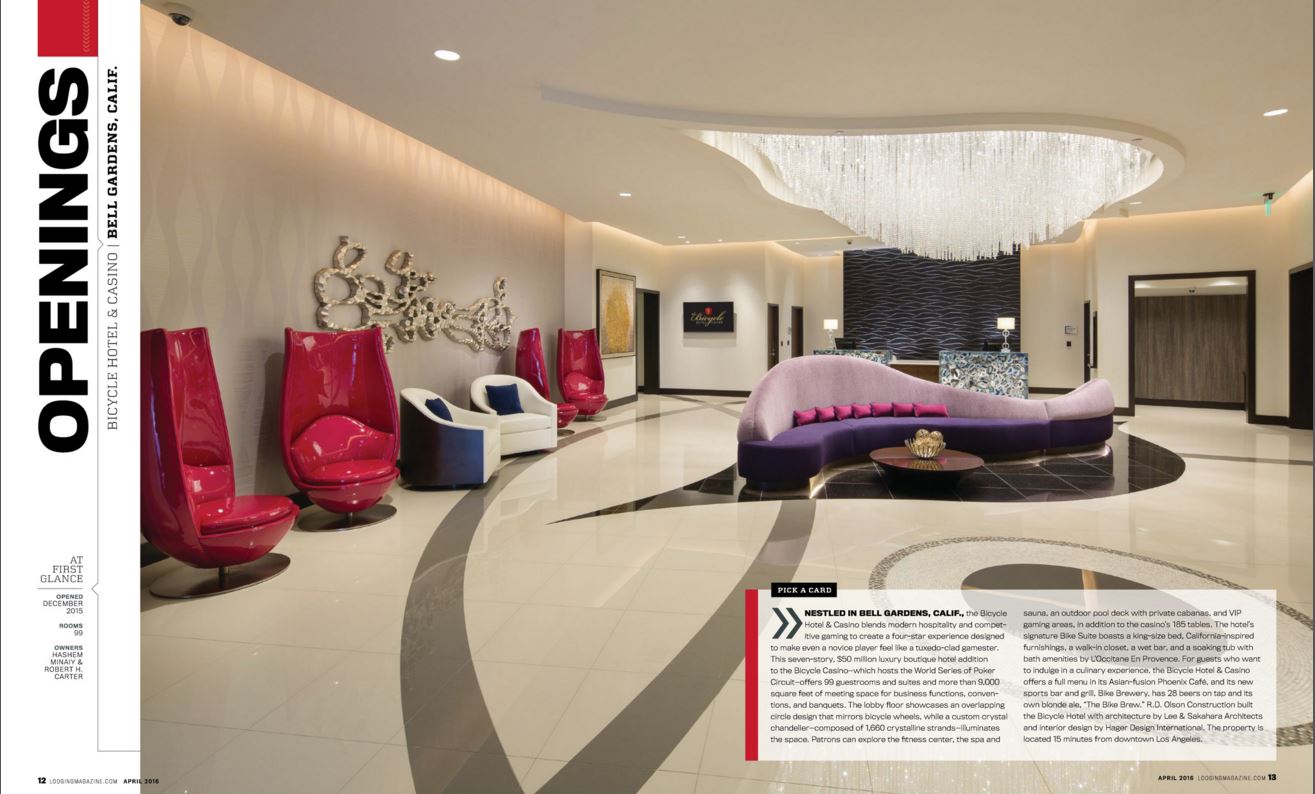THE MANN REPORT – Affordable Housing Stony Oaks
February 10, 2022

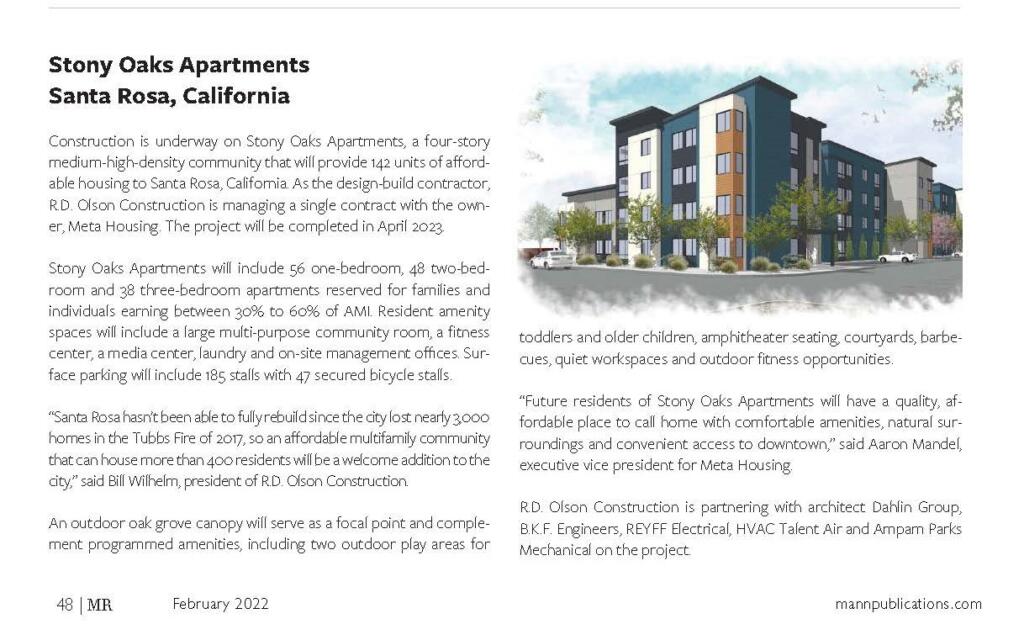
California Home Design – 2021 Builder Awards
December 9, 2021
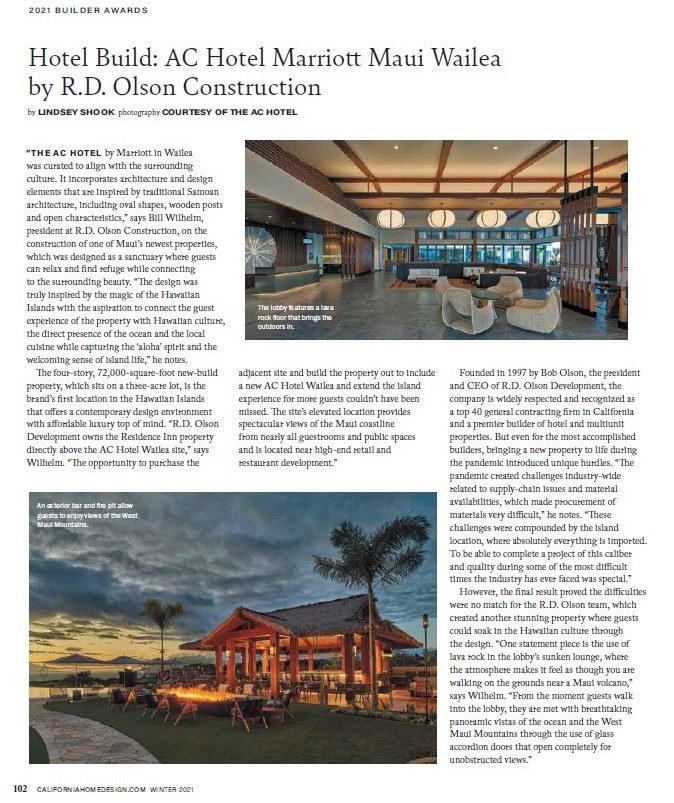
CALIFORNIA BUILDER & ENGINEER
July 8, 2021
R.D. OLSON CONSTRUCTION'S CHARITY GOLF TOURNAMENT RAISES MORE THAN $80,000 FOR OLIVE CREST

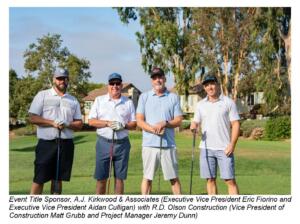
IRVINE, CA — R.D. Olson Construction (RDOC), a general contracting firm in Irvine, California, recently hosted its 11th Annual Charity Golf Tournament, raising more than $80,000 for charity.
All proceeds from the event benefit Olive Crest, an Orange County-based nonprofit organization committed to preventing child abuse, treating and educating at-risk children, and preserving the family.
The tournament was hosted at Tijeras Creek Golf Club in Rancho Santa Margarita, California, and included industry leaders and professionals including Bill Wilhelm, President of R.D. Olson Construction. The morning started with a continental breakfast and putting contest followed by an 8 a.m. shotgun start. After a helicopter ball drop (winner received a $2,500 grand prize), guests were treated to a catered lunch and cocktail reception while the winners from the golf tournament were announced.
“Our annual Charity Golf Tournament brings the commercial real estate industry together for a fun-filled day of golfing and networking while also raising funds for a local charity,” Wilhelm said.
“This year, we're honored to support Olive Crest in their pursuit to end the cycle of child abuse by putting children in the care of strong families and a supportive community.”
Since its inception in 1973, Olive Crest has continued to transform the lives of children through its fostering, foster to adopt, and safe families programs. Olive Crest's model helps prevent abuse and neglect, stops the cycle of child abuse, and enables children and families to become healthy, productive citizens.
R.D. Olson Charity Golf Tournament | 2021
July 2, 2021

Orange County Business Journal | R.D. Olson Ramps Up Affordable Housing Work
February 9, 2021
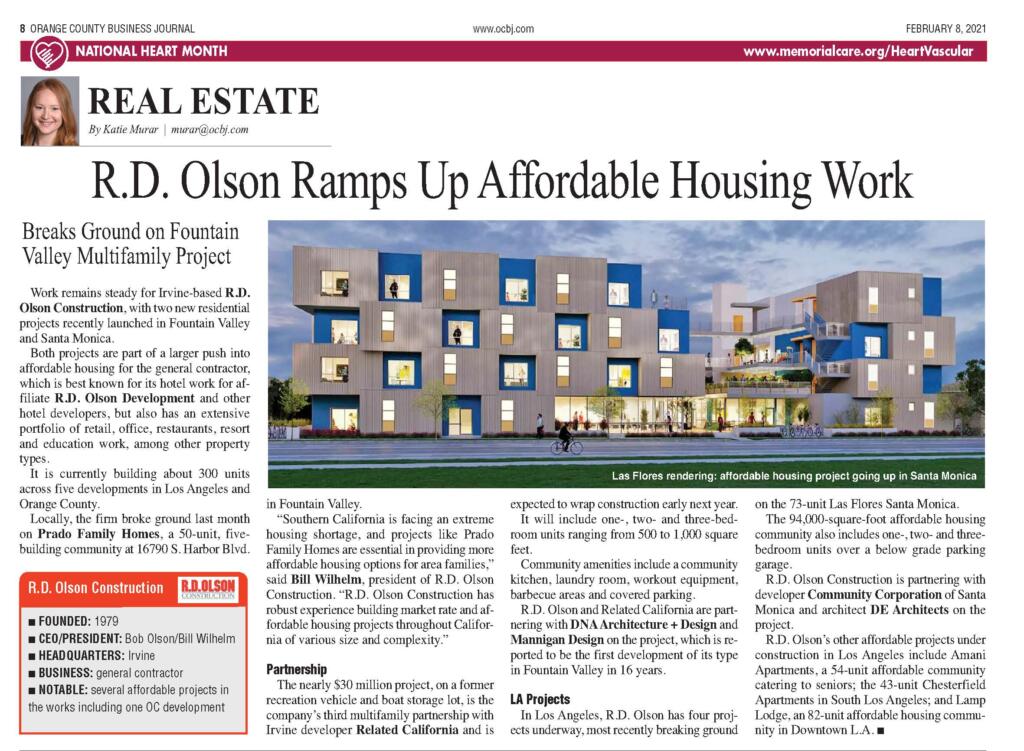
Orange County Business Journal | R.D. Olson Breaks Ground on Apartment, Hotel Project
March 9, 2020
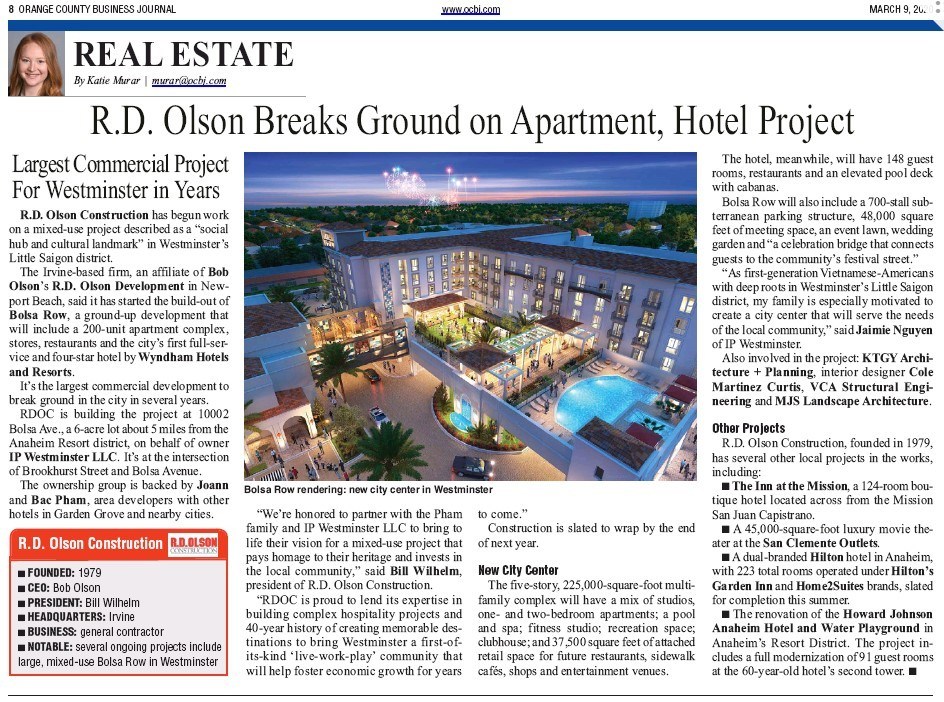
The Mann Report | February 2020 | Architecture Engineering Construction
February 7, 2020
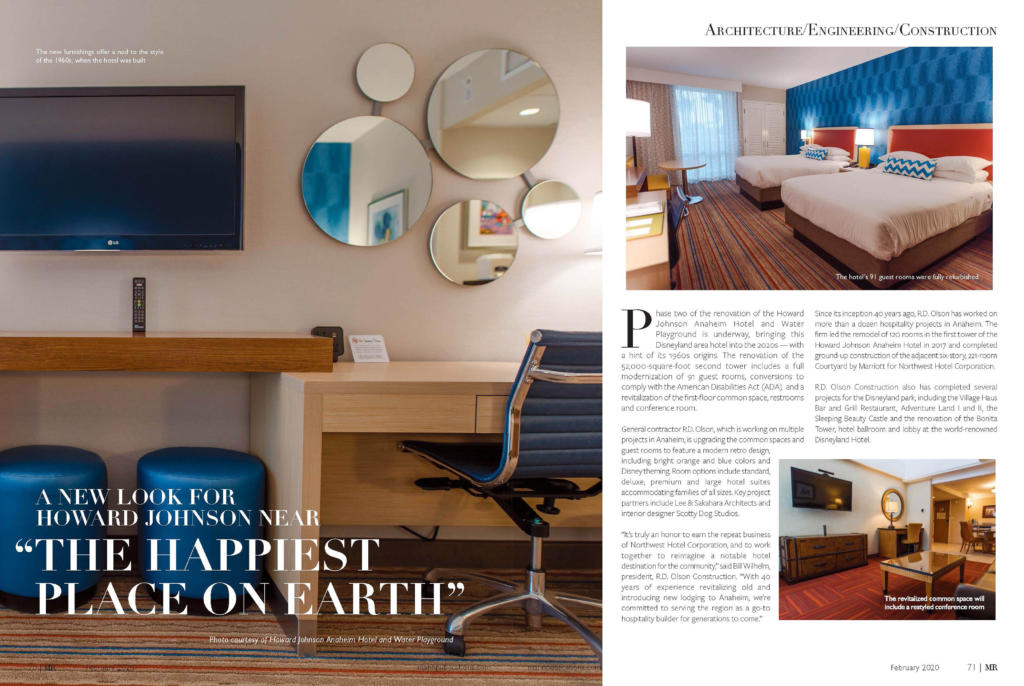
R.D. Olson Construction President Bill Wilhelm Provides 2020 Insight for the Hotel Business Green Book.
January 2, 2020
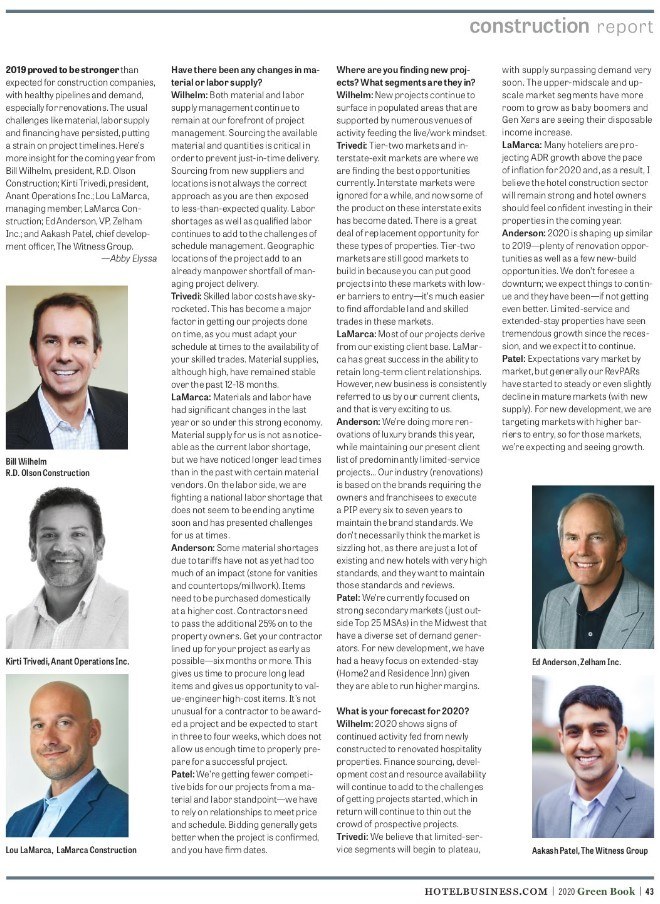
CANstruction 2019
September 16, 2019
This year's CANstruction was the biggest one yet!!
11,600 cans of food, forty people, six months of planning and a lot of fun: R.D. Olson Construction in collaboration with WATG Designs has raised over $16,300 for the OC Food Bank!!
R.D. Olson Construction rated among ENR California’s Top Contractors of 2019
July 24, 2019

R.D. Olson Construction is excited to be rated among ENR California's Top Contractors of 2019!!
Our impressive resume of hospitality, multi-unit, senior living and higher education construction projects matched with our dedicated employees and consistently delivering quality projects that exceed customer expectations keep moving us forward as a leader in the industry.
R.D. Olson Construction Wins Orange County Business Journal’s Best Places to Work for the 4th Year in a Row
July 1, 2019
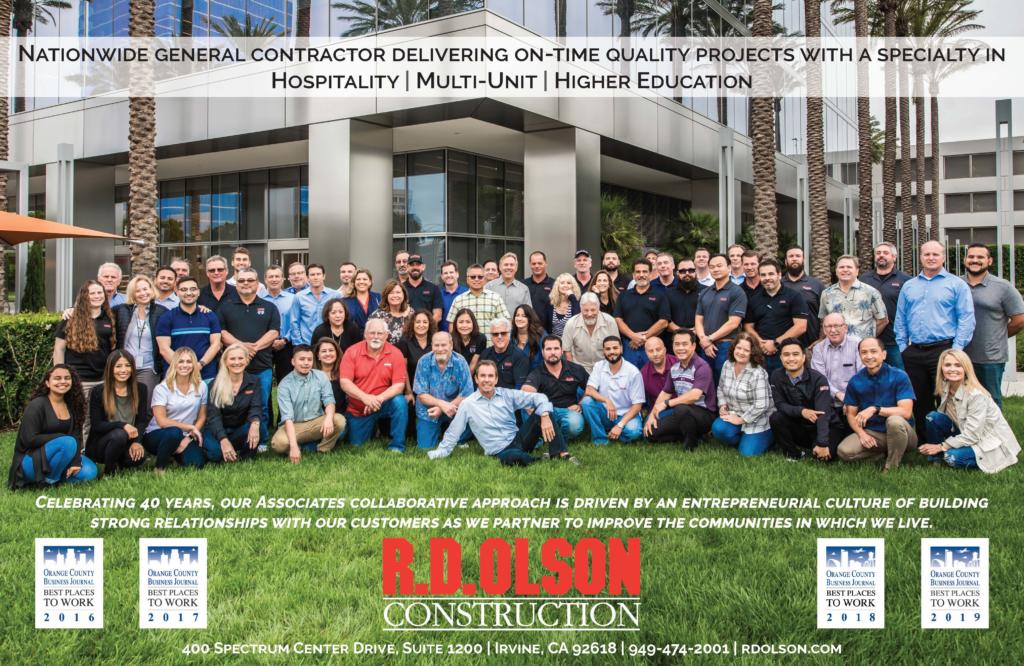
We are a fun, passionate, hard-working group and proud to be among the best companies in the county!!
R.D. Olson Construction ranks among the best in the country on the ENR Top 400 Contractors List again
May 22, 2019

May 2019 – Engineering News Record – Irvine, CA - For several consecutive years, R.D. Olson Construction has continued to be among the Top Contracting firms in the nation, making the distinguished ENR Top 400 List of Contractors again for 2019. Top awarded projects include the Dual Brand Residence Inn and Courtyard Marriott Hotel in Marina del Rey, AC Hotel by Marriott El Segundo, Chapman University's West Residential Village Student Housing in Orange, Kings 838 Apartment Homes in West Hollywood, and The Curve at West Angeles Senior Apartments in Los Angeles, among others in the hospitality, multi-unit, higher education and senior living sectors. R.D. Olson Construction's ongoing success is attributed to the company's dedication to attracting the best talent in the industry, strong customer loyalty, and quality projects built on time that exceed customer expectations. View the full ENR Top 400 list here.
Three Questions With … Bill Wilhelm
May 10, 2019
By Janis L. Magin | Pacific Business News
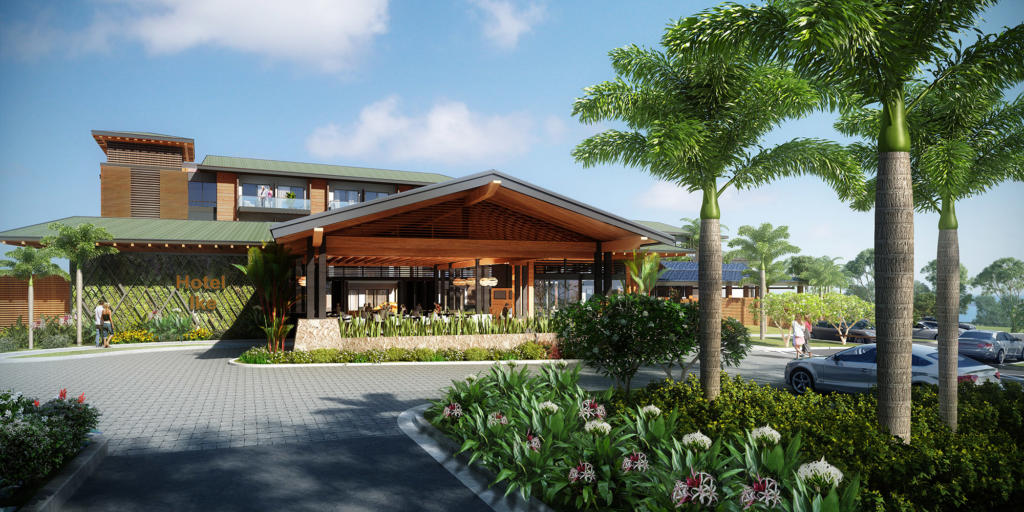
COURTESY AHL
R.D. Olson Construction has completed more than a dozen hotel and retail projects in Hawaii in the 25 years President Bill Wilhelm has been with the company, the latest a new hotel on Maui— Hawaii’s first AC Marriott.
The new hotel is located next door to another R.D. Olson project in Wailea, the Residence Inn by Marriott, Wailea, which was completed in fall 2016. R.D. Olson also built the Courtyard by Marriott Maui Kahului Airport and completed the renovation in 2010 of the former Yacht Harbor Tower in Waikiki into the Waikiki Edition, which then became The Modern Honolulu.
Wilhelm, who was named president in 2014, recently told Pacific Business News that the California-based company’s focus is project specific, and said its success building in the Islands comes down to relationships and managing logistics.
“It’s all about managing resources and where do you place them at a point in time,” Wilhelm recently told Pacific Business News. “Over the many years of having relationships with a subcontractor community that just adds to our overall success.”
R.D. Olson Construction is an affiliate of R.D. Olson Development, developer on the Maui hotel projects, including the AC Marriott, which was designed by AHL, formerly known as Architects Hawaii Ltd. The companies are currently working on plans for yet another Maui hotel project —this one on five acres it plans to purchase from Alexander & Baldwin down the street from the airport hotel.
How is building in Hawaii compared to the Mainland?
We are fortunate we have been present in Hawaii for quite a few years. Whether it’s Hawaii or building over on Catalina Island … it’s creating partnerships with our local subcontractor communities. Understanding site logistics, shipping materials to Hawaii, you have to be on your “A” game when it comes to coordination. Today it’s not just the materials – but the manpower resources [too].
What’s the biggest challenge with working in Hawaii?
I guess the challenge is that there is a greater appreciation for quality. The mentality is a little more cautious on what we produce, which is impressive, whereas in other parts of the country, which I see more and more of, is everybody’s trying to generate production and move on. I’d be lying if I didn’t say getting labor and materials isn’t tough.
Do you do design-build projects?
Yes. Because we have that kind of engagement with our sister company and other clients. We’re asked quite often ‘what architect would you bring in?’ It’s an expanded version of design assist – we’re kind of driving the boat.
At The Forefront
April 26, 2019
R.D. Olson Celebrates its 40th Anniversary and Ushers in a New Era
By Kat Zeman | Construction Today Magazine

Q&A – The Art of Being a CFO
January 14, 2019
By Peter J. Brennan | Orange County Business Journal

Interview with Erika Urbani, VP of Finance, CFO at R.D. Olson Construction
The role of a CFO has evolved significantly, due in part to new technologies, regulations and industry advances. As CFO, my focus is not solely on revenue growth but organic growth. This means a shift in responsibilities from financial reporting, forecasting and budgeting, to leading the company in more strategic ways that ensure the overall success of the business.
Successful CFOs are ‘strategists’ – and our role has expanded to focus on:
Clear the Path. CFOs go beyond keeping operations flowing by ensuring appropriate resource allocation, availability of productivity tools and compliance. This often requires us to revisit company policies and find creative solutions to expedite work. We identify ways to optimize the business – to eliminate a step, a piece of paper, or a signature.
Think Big. Despite day-to-day issues that require our time and attention, supporting organic growth requires us to become strategic partners. Each month I meet with our president to discuss our pipeline of construction projects and we ask ourselves and our teams, “What are our barriers to success and peace of mind?” Once we identify these pain points, we find calculated solutions. For RDOC, the result has been financial stability and strategic growth.
Mentors and Succession. I'm often asked the best path to CFO. The truth is you don’t learn the intricacies of being an accomplished CFO in school. While the strongest CFOs earn multiple degrees, it’s the years of hard-earned and hands-on experience that qualifies them to make gut-based decisions and be successful leaders. Leadership tends to be an overlooked skill, but for a CFO it’s more important than the transactional know-how, because it’s what you don’t see in the data that can bite you. It’s up to us to mentor our up-and-coming CFOs on how to be efficient leaders. Those that master the art of mentorship are not only rewarded with strong teams but hope for the future of their industry and confidence in passing the baton.
Double Shot of Hotel Development
November 12, 2018
Dual-Branded Model Makes Local Inroads
By Mark Mueller | Orange County Business Journal
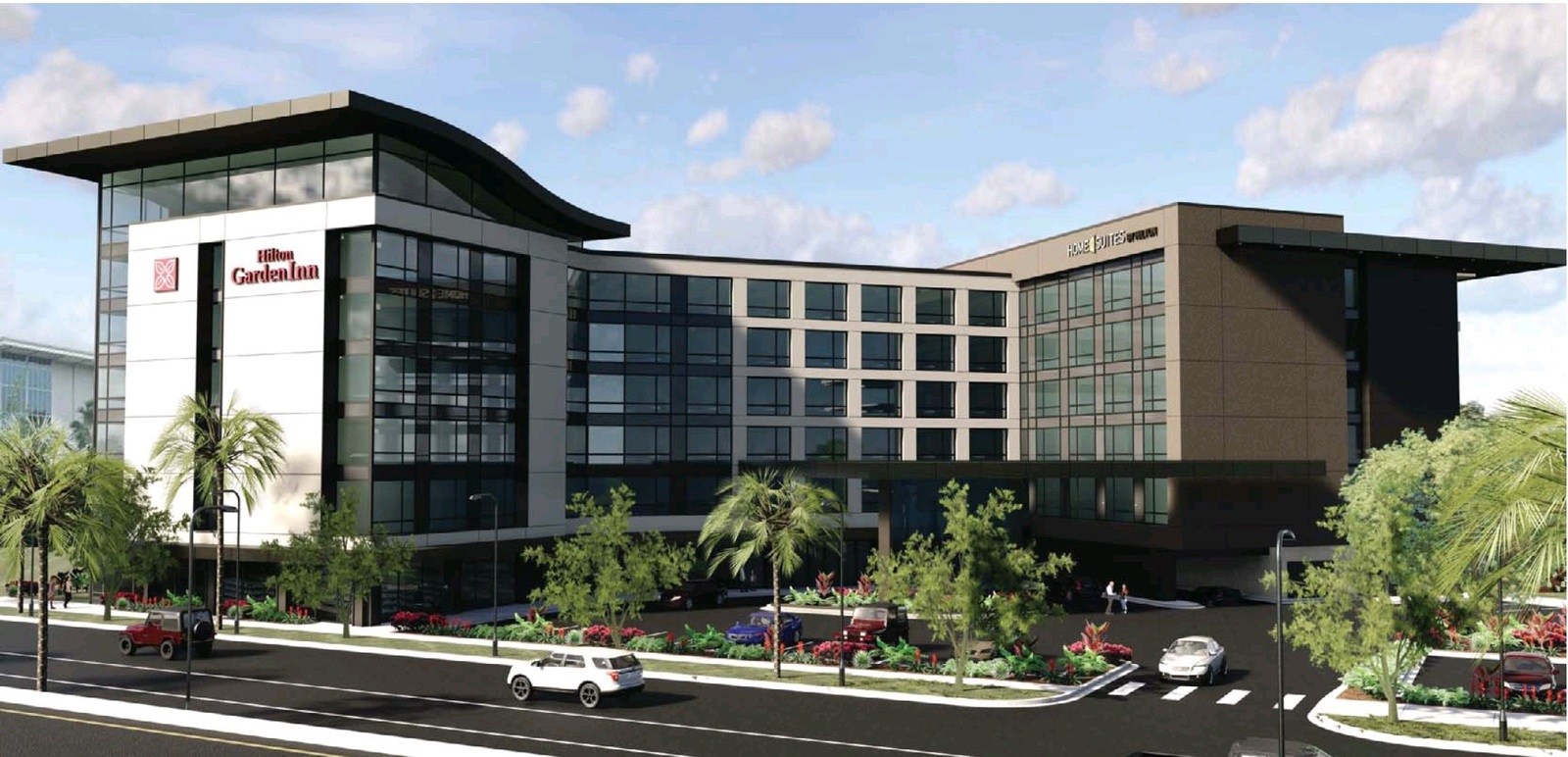
Hotel developers in and around Orange County are seeing double.
Area hotel construction—already in overdrive, especially in the Anaheim resort area— has been accelerating around dual-brand hotel projects, those featuring two hotel properties within the same brand company, such as Hilton or Marriott, at the same site. On some projects, the two hotels are connected, while others put them next to each other on the same grounds. The trend is national, according to a recent report by Los Angeles based hotel consulting group HVS. “Just as the early 2000s realized the proliferation of the boutique hotel concept, the second decade of the new millennium will arguably be known for the growth of the dual-brand hotel concept,” the August report said.
It’s “one of the top three topics” in the industry, said Bill Wilhelm, president of Irvine-based R.D. Olson Construction. The other two hot topics, according to Wilhelm, are figuring out the stage of recovery the hospitality industry is in, and how it can better attract employees in a time of high employment. “In the last four to five years, in the hospitality industry, this has really taken off,” he said of the dual-branding model.
Anaheim, Orange Wilhelm’s construction firm is plenty familiar with the dual-brand phenomenon. In Anaheim, it’s working with locally based developer Nara Investments to build a 125-room Hilton Garden Inn, which will be connected to a 98-room Hilton Home 2 Suites. Ground recently broke on the six-story property immediately west of the Santa Ana (5) Freeway on Manchester Avenue. It’s being built on the former site of a 108-room Quality Inn that was demolished to make way for the new project. The developers also own a nearby Holiday Inn Express. The site, about half a mile from the entrance to Disneyland, will feature a “unique Kids Splash Pad water park,” according to marketing materials for the project, which was designed by BRR Architecture and Studio 11 Design.
About two miles away in Orange, Wilhelm’s firm is working with DCSG Development of Pasadena on a dual-brand project just east of the 5 Freeway on West Chapman Avenue and along the Santa Ana River. The project will feature a 194-room Courtyard by Marriott hotel and a 112-room Residence Inn at the same site, which was previously home to a Motel 6. Construction is due to kick off in about two months. It was designed by Architects Orange and Level 3 Design Group.
Costs, Synergies Developers like the dual-brand concept largely for cost and efficiency savings. “If you put can put two [hotels] on the same property, it can reduce operational costs and back-house costs,” Wilhelm said. That typically means one set of meeting rooms, one swimming pool, and one main kitchen. It also typically means one set of entitlements. From a marketing perspective, the concept can be a good loyalty builder, introducing visitors at one brand to another type of brand they might not have been familiar with. The concept also mitigates some demand risk. “If you’re a developer, maybe a 300-key property [of the same type] doesn’t make sense,” Wilhelm said. But a mix and match of a boutique brand; select-service; limited-service; or extended-stay property could be justified if each has 100 to 150 rooms, he said.
The biggest project risk is “figuring out which [product type] works together and what doesn’t.” Wilhelm said. You “are still building for two different types of customers.”
Tustin Model R.D. Olson Development, the Newport Beach-based development arm of Wilhelm’s construction company, took on its first local dual-brand project when it opened Tustin Pacific Center in 2013, a two-hotel project next to the Costa Mesa (55) Freeway targeting business travelers. The project features a 145-room Fairfield Inn & Suites and a 149-room Residence Inn, both by Marriott. The hotels, which R.D. Olson Development sold in 2015 as part of a $103 million portfolio sale, are on separate sides of the roughly 7.5-acre site. Today, integration is more likely than two stand-alone projects.
“You’re seeing different [models],” said Wilhelm, whose firm is building a dual Marriott-branded project along the water in Marina Del Rey in Los Angeles County, and opened a 290-room H Hotel a year ago near Los Angeles International Airport that features a Curio by Hilton and a Homewood Suites. Nowadays, you might even see a property that swaps hotel type on alternating floors, or two flags on the same floor, Wilhelm said.

Olive Crest Residential Home Kitchen Renovation
September 14, 2018 – Residential Contractor Magazine - September 2018
R.D. Olson Construction, an award-winning general contracting firm in Irvine, Calif., partnered up with TCA Architects and local subcontractors to renovate nonprofit Olive Crest’s short-term residential therapeutic home in Santa Ana. “Demo day” occurred Saturday, Sept. 1 at 8 a.m.and kicked off the renovation of the 1954 home’s kitchen and living areas. Improvements will include new flooring, appliances, water heater, AC and other amenities to provide a more comfortable environment for the six young women living in the house. Founded in 1973, Olive Crest provides safe, residential facilities to house Orange County youth. R.D. Olson Construction and TCA Architects are donating their time on the project, and most materials and labor are being sponsored through the subcontractor and material supplier community.
R.D. Olson’s relationship with Olive Crest began more than 15 years ago when it took the lead in building a multi-purpose facility for families in Riverside. It has continued to provide support to this deserving nonprofit each year through holiday donations, back-to-school drives and the donation of amenities and supplies for residents to help the nonprofit further its important mission of preventing child abuse, treating and educating at-risk children and preserving families.
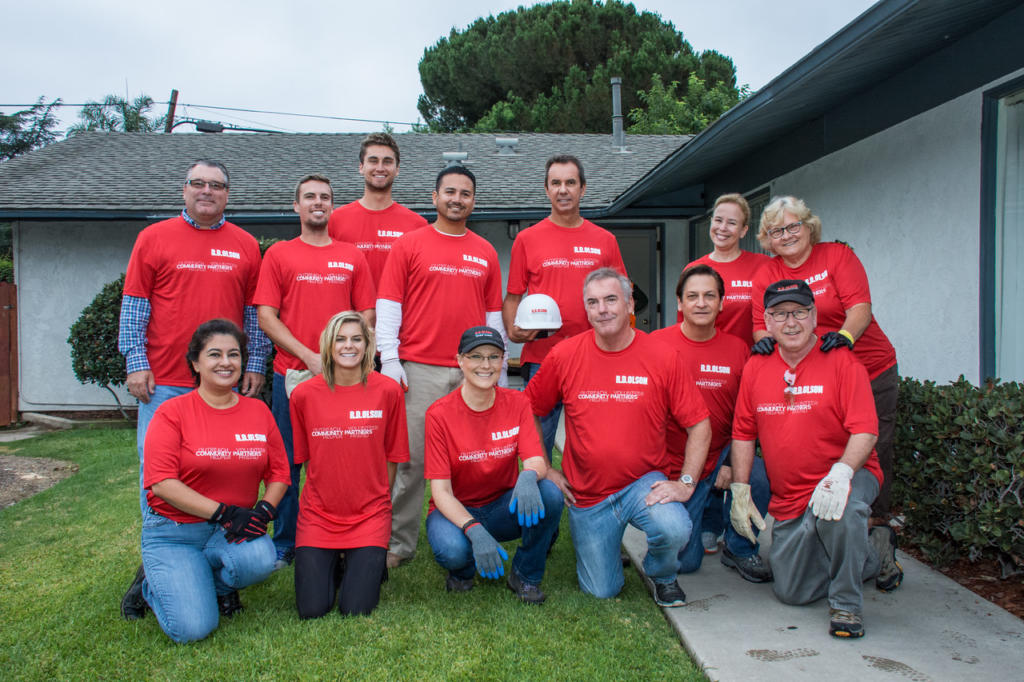
R.D. Olson Construction Named Civic 50 Orange County Honoree for the 2nd Year in a Row
September 10, 2018
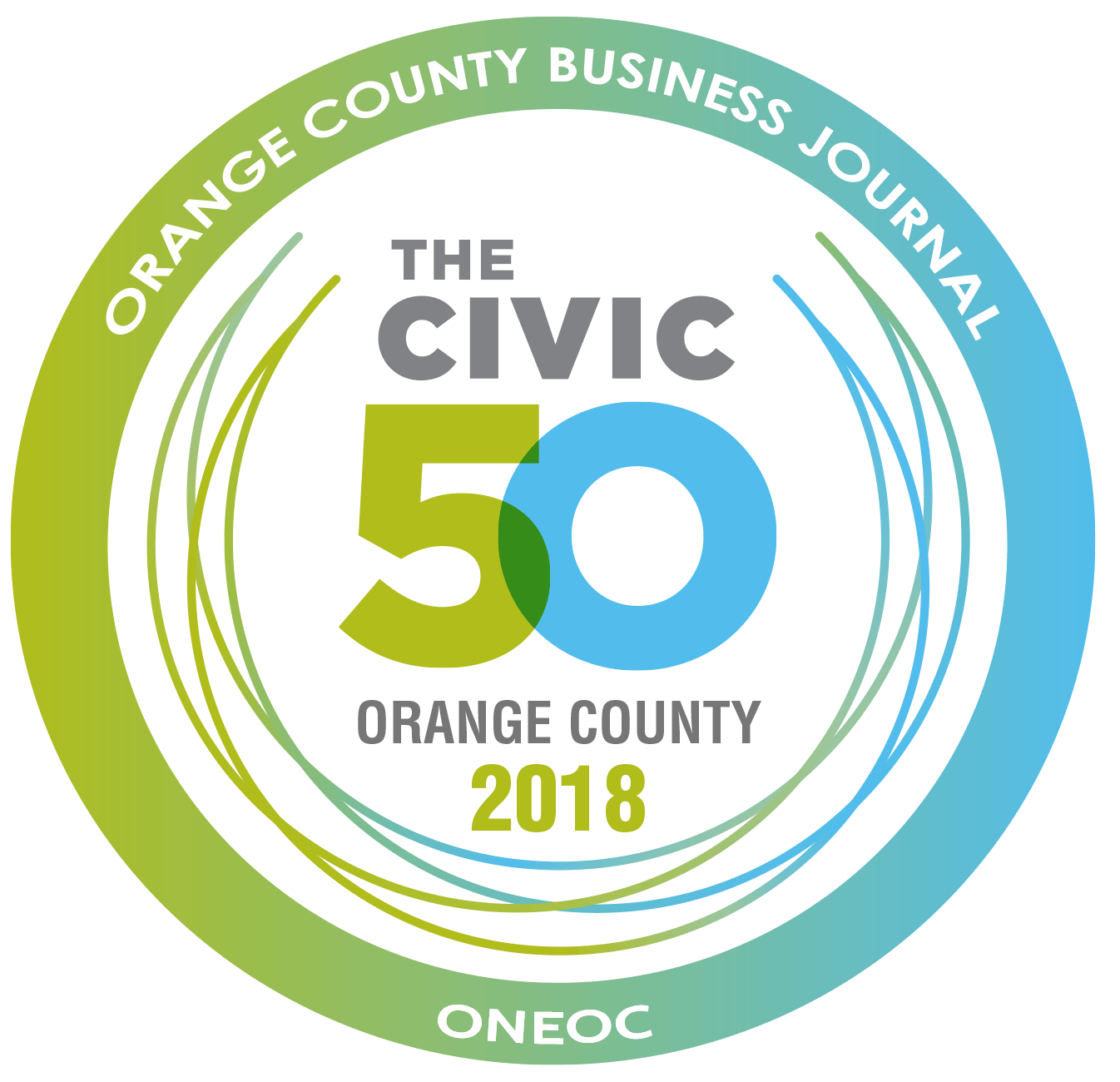 The Orange County Business Journal announces the 50 most community-minded companies in Orange County. The Civic 50 Orange County, presented by the Orange County Business Journal (OCBJ) in partnership with OneOC, provides a local standard for superior corporate citizenship and showcases how companies can use their time, skills and other resources to improve the quality of life in the community where they do business. Since 2012, The Civic 50 has recognized the 50 most community-minded companies in the nation each year as determined by an annual survey developed by True Impact. For Orange County, honorees were determined using True Impact’s adapted national Civic 50 online survey that is independently administered and scored.
Companies were selected based upon four dimensions of their community engagement programs: investment, integration, institutionalization and impact. The Civic 50 OC honorees include businesses from three categories: small, medium and large (based on OC workforce). The second annual Civic 50 OC Awards Luncheon will be held October 11, 2018 at the Hotel Irvine featuring keynote speaker Arthur Woods, co-founder of Imperative. All 50 honorees will be recognized at the event, and five awards will be given in the following categories: small, medium and large; emerging; and legacy.
The Orange County Business Journal announces the 50 most community-minded companies in Orange County. The Civic 50 Orange County, presented by the Orange County Business Journal (OCBJ) in partnership with OneOC, provides a local standard for superior corporate citizenship and showcases how companies can use their time, skills and other resources to improve the quality of life in the community where they do business. Since 2012, The Civic 50 has recognized the 50 most community-minded companies in the nation each year as determined by an annual survey developed by True Impact. For Orange County, honorees were determined using True Impact’s adapted national Civic 50 online survey that is independently administered and scored.
Companies were selected based upon four dimensions of their community engagement programs: investment, integration, institutionalization and impact. The Civic 50 OC honorees include businesses from three categories: small, medium and large (based on OC workforce). The second annual Civic 50 OC Awards Luncheon will be held October 11, 2018 at the Hotel Irvine featuring keynote speaker Arthur Woods, co-founder of Imperative. All 50 honorees will be recognized at the event, and five awards will be given in the following categories: small, medium and large; emerging; and legacy.R.D. Olson Construction Makes Moves on the Top 400 Contractors List
May 29, 2018 – Engineering News Record - May 2018
 Irvine, CA – Thanks to our associate's continued dedication to excellence, we once again were able to make 2018 ENR (Engineering News-Record) Top 400 Contractors List. This award is a great measure of the success R.D. Olson has seen in the last few years and exemplifies the organization’s continuous pursuit of top notch service and quality projects in the hospitality, restaurant, multi-family, retail and entertainment sectors. We charted at #325 up from last year's #338 position and we know 2019 holds bigger and better things. You can view the complete list of contractors here.
Irvine, CA – Thanks to our associate's continued dedication to excellence, we once again were able to make 2018 ENR (Engineering News-Record) Top 400 Contractors List. This award is a great measure of the success R.D. Olson has seen in the last few years and exemplifies the organization’s continuous pursuit of top notch service and quality projects in the hospitality, restaurant, multi-family, retail and entertainment sectors. We charted at #325 up from last year's #338 position and we know 2019 holds bigger and better things. You can view the complete list of contractors here.
Inside Irvine’s First Full Service Hotel in a Decade
April 13, 2018 – Globe St. - by Kelsi Maree Borland
 THE NEW $120 MILLION IRVINE SPECTRUM MARRIOTT IS THE FIRST FULL-SERVICE HOTEL TO HIT THE MARKET IN A DECADE, AND DEVELOPER R.D. OLSON SAYS THAT IT FILLS A BIG HOLE IN THE MARKET.
The first full-service hotel in more than a decade has opened in Irvine. R.D. Olson Construction has completed construction of the Irvine Spectrum Marriott, a $120 million 15-story full-service hotel. The project fills a void for high-end product in the market, which is popular for leisure and business travelers. It will specifically target millennial travelers with a host of amenities and food and beverage options.
“Our vision was really to create a hotel that fit in with Irvine Ranch. There is a rich history of Irvine Ranch, which has gone from ranches and farms to universities,” Bob Olson, president of R.D. Olson Development, tells GlobeSt.com. “It has been a great evolution. Our vision was to create a hotel that is reflective of where we are. To be able to reflect that history through the artwork and the design was a lot of fun.”
The absence of full-service hotel development in Irvine says more about economic prosperity than demand, according to Olson. Select-service is more cost effective to build, and as a result, more of that hotel product type has come to market. “To be honest, investors prefer select-service hotels. I though the full-service piece was missing in the market,” explains Olson. “There was not a full service hotel to the extent that it created an opportunity for us. It was really a big hole in the donut, and we stepped up and filled it. We met what the market wanted, and that can be hard to determine. We found that a lot of travelers in this market were not staying in the area because there wasn’t high enough lodging, and that was especially true for business customers.”
The developer felt the demand justified the project. Since, the market has seen healthy growth, especially in the office sector, inflating the need for full-service hotel. “We pulled the trigger on this project three years ago, and at the time, the economy was healthy, but growing at a sluggish pace,” says Olson. “There wasn’t the confidence then that you see today in the hotel market, but we felt confident in the Irvine Spectrum market. We thought that long-term, it was a great place to do business, and today, it really is becoming the business center of Orange County. I think that this will emerge as one of the leading business centers in Southern California.”
While there were some pessimists about the project, Olson says that the positive traction has already proven the success of the hotel. “Our customers love the hotel. Guests are going to run into both locals and travelers on the rooftop bar,” he says. There is a great pulling together and a sense of place.”
The developer plans to hold the property for the long term.
THE NEW $120 MILLION IRVINE SPECTRUM MARRIOTT IS THE FIRST FULL-SERVICE HOTEL TO HIT THE MARKET IN A DECADE, AND DEVELOPER R.D. OLSON SAYS THAT IT FILLS A BIG HOLE IN THE MARKET.
The first full-service hotel in more than a decade has opened in Irvine. R.D. Olson Construction has completed construction of the Irvine Spectrum Marriott, a $120 million 15-story full-service hotel. The project fills a void for high-end product in the market, which is popular for leisure and business travelers. It will specifically target millennial travelers with a host of amenities and food and beverage options.
“Our vision was really to create a hotel that fit in with Irvine Ranch. There is a rich history of Irvine Ranch, which has gone from ranches and farms to universities,” Bob Olson, president of R.D. Olson Development, tells GlobeSt.com. “It has been a great evolution. Our vision was to create a hotel that is reflective of where we are. To be able to reflect that history through the artwork and the design was a lot of fun.”
The absence of full-service hotel development in Irvine says more about economic prosperity than demand, according to Olson. Select-service is more cost effective to build, and as a result, more of that hotel product type has come to market. “To be honest, investors prefer select-service hotels. I though the full-service piece was missing in the market,” explains Olson. “There was not a full service hotel to the extent that it created an opportunity for us. It was really a big hole in the donut, and we stepped up and filled it. We met what the market wanted, and that can be hard to determine. We found that a lot of travelers in this market were not staying in the area because there wasn’t high enough lodging, and that was especially true for business customers.”
The developer felt the demand justified the project. Since, the market has seen healthy growth, especially in the office sector, inflating the need for full-service hotel. “We pulled the trigger on this project three years ago, and at the time, the economy was healthy, but growing at a sluggish pace,” says Olson. “There wasn’t the confidence then that you see today in the hotel market, but we felt confident in the Irvine Spectrum market. We thought that long-term, it was a great place to do business, and today, it really is becoming the business center of Orange County. I think that this will emerge as one of the leading business centers in Southern California.”
While there were some pessimists about the project, Olson says that the positive traction has already proven the success of the hotel. “Our customers love the hotel. Guests are going to run into both locals and travelers on the rooftop bar,” he says. There is a great pulling together and a sense of place.”
The developer plans to hold the property for the long term.Building Relationships and Communities
April 11, 2018 – Affordable Housing News - Spring 2018
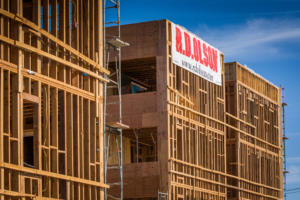 A California-based developer exceeds expectations when it comes to affordable housing
By focusing on forming strong relationships with clients, developers and the communities in which it works, R.D. Olson Construction has achieved success in more ways than one.
With a range of new efforts in the affordable housing space, the firm seeks to make an impact for limited-income residents while cultivating a close-knit company culture.
According to President Bill Wilhelm, the success of R.D. Olson is due largely to its commitment to these relationships.
“We are after growth, but we’re after growth in relationships and partnerships with our existing company base and our new future customer base,” Wilhelm says. “We are not out chasing a number. We know that our financial growth will [increase] with our success with partners and customers.”
Wilhelm has been part of the R.D. Olson team since 1994. Over the years, he has witnessed the company move from a somewhat small general contractor to one of the industry leaders in ground-up and renovation construction.
Pursuing loyalty
R.D. Olson focuses on serving the needs of its existing customer base above all else. Returning business makes up about two-thirds of its current portfolio, and Wilhelm hopes that this figure will continue to grow in the coming years.
“Part of our short- and long-term goal is to increase the repeat business,” Wilhelm says. “About 70 percent of our volume is repeat business, and that tells you what kind of company we have. It’s one that truly is focused on quality over quantity. When you have that kind of approach, success is always right in front of you.”
R.D. Olson has participated in the development of projects ranging from restaurants to hotels. More recently, it has branched out into affordable housing. One of its recent efforts, the Village at Calabasas, added 180 units of housing to a community in southern California. The property was completed in 2016.
Fullerton Family Housing in Orange County is now under construction and, upon its completion in spring of 2018, will offer 55 units of affordable housing. The site itself is compact, requiring some creativity to make the most of the development.
“It’s almost like putting a property on a postage stamp,” Wilhelm says. “We are maxing out this site with open space, including decks, walkways and things of that nature.”
Despite the limited space for construction, development at Fullerton Family Housing is taking place with careful attention to architecture and aesthetics.
“The rooms are very spacious,” Wilhelm says. “Sometimes, you get the wrong impression when you hear the words ‘affordable housing.’ These are nice units. They’re spacious, and the finishes are definitely above the standard in the industry. It’s just a great property.”
R.D. Olson has a time-lapse construction camera accessible through its website, allowing members of the public to see progress in real time.
“Our customer base loves it, our people love it and even our community loves that they can watch their community grow,” Wilhelm says. “We get a lot of feedback about how powerful that webcam is on our job sites.”
As for the community in Fullerton, Wilhelm says that the reception of the new development has been overwhelmingly positive. R.D. Olson’s focus on building relationships within the community has led to a strong reputation for the firm.
“From what I can see, I think that the community has welcomed it with open arms,” Wilhelm says. “[Opposition] is just a part of revitalization, but the city has worked with the design team very closely on the aesthetics of the building and the general appearance so that it will blend in well with the city of Fullerton.”
R.D. Olson’s commitment to delivering exceptional products remains at the forefront of this new affordable housing development.
“If we’re going to do it, let’s do it right,” Wilhelm says. “Let’s beautify it and let’s make it feel like it is a true part of our community.”
Investing in people
Achieving success over the course of nearly four decades has required a level of commitment to clients and employees alike. In the coming years, Wilhelm says R.D. Olson will continue to invest in its employees, giving them opportunities to take on leadership roles within the company.
“We are looking at our next generation of leaders,” Wilhelm says. “The last few years, we have been continuing to build within the ranks. We know sustainability is not just about having backlog, but also having tenured employees.”
Having an engaged workforce gives R.D. Olson an edge over its competitors and demonstrates its commitment to people.
“I can walk into a presentation and talk about our people and the length of time and experience they have, and typically that gives me a little bit of an advantage over a competitor that I might be up against in this industry,” Wilhelm says. “Our people are the greatest assets that our company has.”
A California-based developer exceeds expectations when it comes to affordable housing
By focusing on forming strong relationships with clients, developers and the communities in which it works, R.D. Olson Construction has achieved success in more ways than one.
With a range of new efforts in the affordable housing space, the firm seeks to make an impact for limited-income residents while cultivating a close-knit company culture.
According to President Bill Wilhelm, the success of R.D. Olson is due largely to its commitment to these relationships.
“We are after growth, but we’re after growth in relationships and partnerships with our existing company base and our new future customer base,” Wilhelm says. “We are not out chasing a number. We know that our financial growth will [increase] with our success with partners and customers.”
Wilhelm has been part of the R.D. Olson team since 1994. Over the years, he has witnessed the company move from a somewhat small general contractor to one of the industry leaders in ground-up and renovation construction.
Pursuing loyalty
R.D. Olson focuses on serving the needs of its existing customer base above all else. Returning business makes up about two-thirds of its current portfolio, and Wilhelm hopes that this figure will continue to grow in the coming years.
“Part of our short- and long-term goal is to increase the repeat business,” Wilhelm says. “About 70 percent of our volume is repeat business, and that tells you what kind of company we have. It’s one that truly is focused on quality over quantity. When you have that kind of approach, success is always right in front of you.”
R.D. Olson has participated in the development of projects ranging from restaurants to hotels. More recently, it has branched out into affordable housing. One of its recent efforts, the Village at Calabasas, added 180 units of housing to a community in southern California. The property was completed in 2016.
Fullerton Family Housing in Orange County is now under construction and, upon its completion in spring of 2018, will offer 55 units of affordable housing. The site itself is compact, requiring some creativity to make the most of the development.
“It’s almost like putting a property on a postage stamp,” Wilhelm says. “We are maxing out this site with open space, including decks, walkways and things of that nature.”
Despite the limited space for construction, development at Fullerton Family Housing is taking place with careful attention to architecture and aesthetics.
“The rooms are very spacious,” Wilhelm says. “Sometimes, you get the wrong impression when you hear the words ‘affordable housing.’ These are nice units. They’re spacious, and the finishes are definitely above the standard in the industry. It’s just a great property.”
R.D. Olson has a time-lapse construction camera accessible through its website, allowing members of the public to see progress in real time.
“Our customer base loves it, our people love it and even our community loves that they can watch their community grow,” Wilhelm says. “We get a lot of feedback about how powerful that webcam is on our job sites.”
As for the community in Fullerton, Wilhelm says that the reception of the new development has been overwhelmingly positive. R.D. Olson’s focus on building relationships within the community has led to a strong reputation for the firm.
“From what I can see, I think that the community has welcomed it with open arms,” Wilhelm says. “[Opposition] is just a part of revitalization, but the city has worked with the design team very closely on the aesthetics of the building and the general appearance so that it will blend in well with the city of Fullerton.”
R.D. Olson’s commitment to delivering exceptional products remains at the forefront of this new affordable housing development.
“If we’re going to do it, let’s do it right,” Wilhelm says. “Let’s beautify it and let’s make it feel like it is a true part of our community.”
Investing in people
Achieving success over the course of nearly four decades has required a level of commitment to clients and employees alike. In the coming years, Wilhelm says R.D. Olson will continue to invest in its employees, giving them opportunities to take on leadership roles within the company.
“We are looking at our next generation of leaders,” Wilhelm says. “The last few years, we have been continuing to build within the ranks. We know sustainability is not just about having backlog, but also having tenured employees.”
Having an engaged workforce gives R.D. Olson an edge over its competitors and demonstrates its commitment to people.
“I can walk into a presentation and talk about our people and the length of time and experience they have, and typically that gives me a little bit of an advantage over a competitor that I might be up against in this industry,” Wilhelm says. “Our people are the greatest assets that our company has.”Olson Construction Seeks Boost in Multiunit Projects
April 9, 2018 – Orange County Business Journal - by Paul Hughes
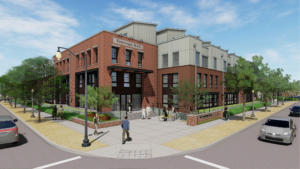 Move Meant to Diversify Mix, Retain Talent
R.D. Olson Construction Inc. has made recent inroads in multiunit contract building and said it will maintain or slightly expand its work in that market as it continues a diversification drive of the past five years in a slowing hotel construction market.
The Irvine-based sister firm to hotel owner-developer R.D. Olson Development Inc. in Newport Beach is largely known as a hospitality construction company.
The Business Journal OC 500's Bob Olson owns both, and the former builds for the latter. R.D. Olson Construction built the Marriott Irvine Spectrum, which opened in March, and the boutique Lido House in Newport Beach, which opens in May.
Last year it was No. 13 on the Business Journal's list of commercial construction companies, down two notches, with $218 million in revenue, down 6%.
Partner and President Bill Wilhelm, who also owns a stake in the company, said it's now at about $225 million in annual revenue - two-thirds from hotels.
About 30% is from multiunit projects, up from 20% in recent years; 97% of multiunit work is affordable housing, student housing and timeshares. and there's a sliver of market-rate, or standard-priced work. Wilhelm wants more mixed-use apartment projects-rental living that includes retail-and to get back to assisted living.
About 5% is from construction of educational campus buildings, which Wilhelm began to increase his focus on about three years ago.
Social Calendar
He aims for 35% of revenue from multiunit construction and 8% from the education work.
If the remix plays out, R.D. Olson Construction's reliance on hotel construction will drop from 75% of business a few years ago to 57% a few years from now.
All of Olson's multiunit work is for-rent product, which bears a striking resemblance to hotels when considered as ultra-short-term rentals-as short as one night.
The hotel business, including construction-Olson's bread and butter-had a five year boom that began a few years after the 2008 recession.
Olson benefitted building, for instance, the Pasea Hotel & Spa in Huntington Beach, an R.D. Olson Development project that opened in 2016. Olson Construction's 2017 revenue of $218 million was twice its annual take as of June 2012, when it was No. 16 on our construction list as $98 million-up 51% year-over-year.
Hotel construction is said to be cooling.
People attending the Americas Lodging Investment Summit, produced each January in downtown Los Angeles by Costa Mesa-based Burba Hotel Network LLC, over the past two years have discussed a market peak over all, a subsequent shaking out in some markets, and which "secondary markets" should now get attention.
Luxe Rental
Orange County still looks strong for hotel construction, according to recent data of consultant and broker Atlas Hospitality Group in Irvine. Market research by L.A.-based CBRE Hotels shows annual boosts of 5.8% in average daily rate, 8.6% in revenue per available room, and 2.6% in occupancy, as of February.
But Olson also builds outside of OC. Wilhelm said its history runs as far east as Atlanta and his vision extends beyond the county's environs with that continued focus on for-rent product.
He means that in a good way.
"With the cost of housing, people are leaving single-family homes and going multifamily," he said.
Empty-nesters cashing out and downsizing or millennial who can't afford to buy-both still want stylish stuff.
Affordable housing in OC is going to be nicer than your average bear cave, and other pieces of the multiunit puzzle also skew higher-end.
Students typically pay above-market rates for rooms, for instance, and healthcare facility owners, such as assisted-living projects, have pushed into properties where residents pay out-of-pocket instead of through Medicare.
Locals involved in those markets include Ladera Ranch-based real estate investment trust Strategic Student & Senior Housing Trust Inc., which has raised about $82 million of a planned $1.1 billion to buy property. Nelson Brothers Professional Real Estate LLC invests in student and senior housing.
Local healthcare facility REITS are to one degree or another looking to private-pay tenants at properties they own.
HCP Inc. has strongly de-emphasized Medicare-related facilities, Sabra Health Care REIT Inc. less so; both are in Irvine.
The Dance
Olson Construction is consequently looking to fill its dance card in workers, colleagues and clients.
It hired Cynthia Cook as business development director six months ago to make it rain on both multiunit deals and education construction.
It strutted its stuff a bit with the renovation of space in old-town Orange across from the train station for the home of the Hilbert Museum, a Chapman University art gallery.
Olson hasn't gotten a lot of revenue from the education pivot yet, but "we're enhancing relationships, and prospects are improving," Wilhelm said.
Cook's hire highlights an intriguing element of the multiunit effort-the need to attract and keep staff.
Our 2017 construction company list showed a 13% jump in Olson's employee count to 123. Wilhelm has to hold those workers in a tight labor market and fill gaps as others retire.
"You need a pipeline to grow and retain talent," he said.
In colleagues and clients, it looks in part to hospitality "project partners" as "excellent referral sources" for new work.
It's building 110-unit student housing project Santiago Hall for Chapman that's scheduled to open in the summer of 2019 and 55-unit affordable-housing apartment deal Citrea in Fullerton near the train station and downtown that's scheduled to open in June.
The developer on the latter is Related California in Irvine, led by the OC 500's William Witte; the designer is IDS Group Inc. in Irvine.
Move Meant to Diversify Mix, Retain Talent
R.D. Olson Construction Inc. has made recent inroads in multiunit contract building and said it will maintain or slightly expand its work in that market as it continues a diversification drive of the past five years in a slowing hotel construction market.
The Irvine-based sister firm to hotel owner-developer R.D. Olson Development Inc. in Newport Beach is largely known as a hospitality construction company.
The Business Journal OC 500's Bob Olson owns both, and the former builds for the latter. R.D. Olson Construction built the Marriott Irvine Spectrum, which opened in March, and the boutique Lido House in Newport Beach, which opens in May.
Last year it was No. 13 on the Business Journal's list of commercial construction companies, down two notches, with $218 million in revenue, down 6%.
Partner and President Bill Wilhelm, who also owns a stake in the company, said it's now at about $225 million in annual revenue - two-thirds from hotels.
About 30% is from multiunit projects, up from 20% in recent years; 97% of multiunit work is affordable housing, student housing and timeshares. and there's a sliver of market-rate, or standard-priced work. Wilhelm wants more mixed-use apartment projects-rental living that includes retail-and to get back to assisted living.
About 5% is from construction of educational campus buildings, which Wilhelm began to increase his focus on about three years ago.
Social Calendar
He aims for 35% of revenue from multiunit construction and 8% from the education work.
If the remix plays out, R.D. Olson Construction's reliance on hotel construction will drop from 75% of business a few years ago to 57% a few years from now.
All of Olson's multiunit work is for-rent product, which bears a striking resemblance to hotels when considered as ultra-short-term rentals-as short as one night.
The hotel business, including construction-Olson's bread and butter-had a five year boom that began a few years after the 2008 recession.
Olson benefitted building, for instance, the Pasea Hotel & Spa in Huntington Beach, an R.D. Olson Development project that opened in 2016. Olson Construction's 2017 revenue of $218 million was twice its annual take as of June 2012, when it was No. 16 on our construction list as $98 million-up 51% year-over-year.
Hotel construction is said to be cooling.
People attending the Americas Lodging Investment Summit, produced each January in downtown Los Angeles by Costa Mesa-based Burba Hotel Network LLC, over the past two years have discussed a market peak over all, a subsequent shaking out in some markets, and which "secondary markets" should now get attention.
Luxe Rental
Orange County still looks strong for hotel construction, according to recent data of consultant and broker Atlas Hospitality Group in Irvine. Market research by L.A.-based CBRE Hotels shows annual boosts of 5.8% in average daily rate, 8.6% in revenue per available room, and 2.6% in occupancy, as of February.
But Olson also builds outside of OC. Wilhelm said its history runs as far east as Atlanta and his vision extends beyond the county's environs with that continued focus on for-rent product.
He means that in a good way.
"With the cost of housing, people are leaving single-family homes and going multifamily," he said.
Empty-nesters cashing out and downsizing or millennial who can't afford to buy-both still want stylish stuff.
Affordable housing in OC is going to be nicer than your average bear cave, and other pieces of the multiunit puzzle also skew higher-end.
Students typically pay above-market rates for rooms, for instance, and healthcare facility owners, such as assisted-living projects, have pushed into properties where residents pay out-of-pocket instead of through Medicare.
Locals involved in those markets include Ladera Ranch-based real estate investment trust Strategic Student & Senior Housing Trust Inc., which has raised about $82 million of a planned $1.1 billion to buy property. Nelson Brothers Professional Real Estate LLC invests in student and senior housing.
Local healthcare facility REITS are to one degree or another looking to private-pay tenants at properties they own.
HCP Inc. has strongly de-emphasized Medicare-related facilities, Sabra Health Care REIT Inc. less so; both are in Irvine.
The Dance
Olson Construction is consequently looking to fill its dance card in workers, colleagues and clients.
It hired Cynthia Cook as business development director six months ago to make it rain on both multiunit deals and education construction.
It strutted its stuff a bit with the renovation of space in old-town Orange across from the train station for the home of the Hilbert Museum, a Chapman University art gallery.
Olson hasn't gotten a lot of revenue from the education pivot yet, but "we're enhancing relationships, and prospects are improving," Wilhelm said.
Cook's hire highlights an intriguing element of the multiunit effort-the need to attract and keep staff.
Our 2017 construction company list showed a 13% jump in Olson's employee count to 123. Wilhelm has to hold those workers in a tight labor market and fill gaps as others retire.
"You need a pipeline to grow and retain talent," he said.
In colleagues and clients, it looks in part to hospitality "project partners" as "excellent referral sources" for new work.
It's building 110-unit student housing project Santiago Hall for Chapman that's scheduled to open in the summer of 2019 and 55-unit affordable-housing apartment deal Citrea in Fullerton near the train station and downtown that's scheduled to open in June.
The developer on the latter is Related California in Irvine, led by the OC 500's William Witte; the designer is IDS Group Inc. in Irvine.Is El Segundo L.A.’s Newest Hot Hotel Market?
March 12, 2018 – Globe St. - Kelsi Marie Borland
Adaptive Reuse: A Growing Trend in High-Density Markets
February 6, 2018 – Hotel Online, written by Bill Wilhelm
4 Ways to Ensure Safety on the Jobsite
February 5, 2018 – Construction Dive, written by Bill Wilhelm
Plan ahead
Long before a job starts, extensive planning should be done to identify which tasks will be taking place onsite and how best to plan for potential safety hazards. Project managers and field representatives should put preventative measures in place and communicate them to workers, and provide the appropriate tools and equipment. Zoning, which involves blocking off areas where certain tasks are taking place, installing catch platforms, nets and other safety measures, is an important part of this planning phase. By allowing only those working on a task within the zoned area past the barrier, it helps to prevent bystander injury. This methodical process also helps ensure that workers within the zoned area have the right protective equipment and tools for that specific job. One-third of all construction fatalities are a result of falls — from buildings, structural elements and ladders — making them one of the most critical safety issues for which to plan. Appropriate scaffolding needs to be installed, holes in the structure need to be cordoned off or otherwise managed, and other potential fall hazards should be planned for before construction begins. Transportation incidents are the second most common issue, with vehicle contact/collision accounting for 29% of fatalities.Manage the risk
Less obvious factors proven to cause safety issues should always be considered when developing and implementing a safety plan. According to a study commissioned by the Associated General Contractors of America (AGC), most deaths on construction sites occur between 10 a.m. and 3 p.m., with fatalities peaking around noon. Almost 75% of fatalities happen on Mondays through Thursdays, with industrial projects reporting more incidents than residential, commercial and other project types. What does this mean for you? Consider scheduling safety meetings around noon during the beginning of the week, and make sure there is a strong protocol for safety during lunch breaks. If you are working on an industrial site, encourage frequent safety meetings and perhaps more stringent safety protocol that accounts for the dangers unique to industrial building. The AGC report also shows that small construction companies with one to nine employees account for a much higher fatality rate (26 per 100,000 workers annually) than larger firms. If you are at a smaller company, don’t make safety planning any less of a priority. There is also a strong correlation between fatalities and the summer months, and deaths are also more common in the South than other areas of the country. This may be due to heat-related illness and exhaustion. Make sure workers have adequate access to water, encourage them to take regular breaks and train them to monitor for heat-related issues.Scheduling and staffing
Another overlooked but pressing safety issue is worker exhaustion. The industry-wide talent shortage can make it difficult to appropriately staff jobsites, leading some companies to over-schedule workers in order to meet demanding construction schedules. But no matter how many preventative measures and education programs you put in place, it’s all for nothing if workers are too physically or mentally worn out to follow protocol. The Occupational Safety and Health Administration (OSHA) reports that accidents and injury rates are 30% greater during night shifts, and working 12 hours per day comes with a 37% increased risk of injury. Safety isn’t just a concern on jobsites, though. Decreased alertness resulting from fatigue has been cited as a contributing factor in major workplace disasters, such as BP's Deepwater Horizon oil refinery explosion, the Challenger space shuttle explosion and the nuclear accidents at Chernobyl and Three Mile Island. Don’t put your construction site at risk for disaster just to shave a few days or weeks off the construction schedule. Extended shifts can be correlated with an increased risk of having a car accident on the way home from work by 16.2%. They can also lead to a higher probability of developing health problems due to prolonged exposure to chemical and noise hazards. Companies can help prevent worker exhaustion, and improve retention, by limiting extended shifts, ensuring employees and subcontractors aren’t working too many hours and taking possible talent shortages into account when creating the project schedule.Safety as a culture
For a safety program to be successful, safety needs to be integral to a company’s culture. Education is one way to instill this. OSHA’s 30-hour Construction Training Course is one example of a valuable program that ensures every worker has the same comprehensive knowledge that can be built upon during company trainings. While the OSHA program is geared toward safety directors, foremen and field supervisors, it is ideal if everyone in the company goes through the training to make sure the takeaways are spread across every level of the organization. Trainings shouldn’t be relegated only to management and employees. It’s best if subcontractors and other partners also receive trainings, ensuring their safety standards are in line with a GC's own. Regular safety events, onsite and off, that teach workers about the latest regulations and give refreshers about existing ones are also critical to promoting a culture of safety. They can range from brief onsite recaps to fun team-building exercises. Regardless of the format, they typically should be done at least weekly to make safety part of workers' daily mindsets. Planning, risk management, staffing and education are all important components of keeping job sites safe. As an industry, we owe it to our workers to prioritize safety and give them all the tools necessary to prevent incidents before they occur.Scoring Newport Beach Bingo
January 19, 2018 – The Real Deal - Kavita Daswani
National general contracting and construction management firm R.D. Olson Construction, based in Irvine, is building the luxury Lido House Hotel in Newport Beach. The hotel, on the site of the former City Hall, is part of Marriott International’s Autograph brand.
Slated to open in the spring of 2018, the 103,000-square-foot, four-story, 130-room hotel is located close to the Lido Marina Village, a shopping and entertainment center, which itself underwent a renovation last year. Developed by DJM Capital Partners, the 116,000-square-foot retail, dining and creative office project now houses trendy eateries such as Nobu and fashion brands such as Elyse Walker and Warby Parker in addition to a 47-slip marina. "
Adaptive Re-Use Emerges as Hotel Sector’s Hedge Against Risk
January 12, 2018 – Connect Media
 The hotel sector in Southern California is booming. Los Angeles County set a record for drawing tourists last year, hosting nearly 50 million visitors in 2017. That was a 2.2% increase over the record 47.3 million tourists in 2016.
To gain a better understanding of trends shaping the industry, Connect Media asked Bill Wilhelm, President of Irvine, CA-based R.D. Olson Construction, to share insights. The company recently completed the dual-brand H Hotel at LAX, which is part of Hilton’s Curio Collection and Homewood Suites in Los Angeles.
Q: Why has adaptive re-use become more prevalent than new construction in the hotel industry?
A: In the past few years, there has been an increase in demand for adaptive re-use projects over ground-up construction in high-density areas with limited space available for new construction. At R.D. Olson Construction, about 60% of our projects are now in adaptive re-use and large-scale renovations, largely because many of our projects are in the high-demand Southern California market.
In an industry of highly commoditized hotel chains, adaptive re-use gives hotel developments a competitive advantage through the unique character and creative use of space that differentiates these types of buildings. Second, adaptive re-use is more cost-efficient, reducing the price of materials and construction equipment. Furthermore, having an existing structure to build upon makes adaptive re-use a speedier process, allowing hotels to go to market much faster.
Q: In the current economic climate, is adaptive re-use a good hedge against a potential downturn?
A: Yes, adaptive re-use is a good hedge because it allows for much shorter timelines, which reduces the risk that a recession or other economic downturn will happen mid-project and allows the hotel to start becoming profitable faster by getting guests in the door sooner. It also allows for more flexibility to adapt to new trends and changes in supply and demand levels. A smaller investment is required for adaptive re-use, which also is appealing in the case of a downturn.
Q: Are there non-economic benefits to adaptive re-use as well?
A: More than economic gain, adaptive re-use offers social and environmental benefits. Adapting old structures for new purposes allows developers to preserve any cultural and historical significance a site has for the surrounding community. In addition, adaptive re-use projects reduce energy consumption typically caused by demolition, additional machinery and the use and transportation of raw materials. Overall, the energy output for adaptive re-use is much less than ground-up construction.
The hotel sector in Southern California is booming. Los Angeles County set a record for drawing tourists last year, hosting nearly 50 million visitors in 2017. That was a 2.2% increase over the record 47.3 million tourists in 2016.
To gain a better understanding of trends shaping the industry, Connect Media asked Bill Wilhelm, President of Irvine, CA-based R.D. Olson Construction, to share insights. The company recently completed the dual-brand H Hotel at LAX, which is part of Hilton’s Curio Collection and Homewood Suites in Los Angeles.
Q: Why has adaptive re-use become more prevalent than new construction in the hotel industry?
A: In the past few years, there has been an increase in demand for adaptive re-use projects over ground-up construction in high-density areas with limited space available for new construction. At R.D. Olson Construction, about 60% of our projects are now in adaptive re-use and large-scale renovations, largely because many of our projects are in the high-demand Southern California market.
In an industry of highly commoditized hotel chains, adaptive re-use gives hotel developments a competitive advantage through the unique character and creative use of space that differentiates these types of buildings. Second, adaptive re-use is more cost-efficient, reducing the price of materials and construction equipment. Furthermore, having an existing structure to build upon makes adaptive re-use a speedier process, allowing hotels to go to market much faster.
Q: In the current economic climate, is adaptive re-use a good hedge against a potential downturn?
A: Yes, adaptive re-use is a good hedge because it allows for much shorter timelines, which reduces the risk that a recession or other economic downturn will happen mid-project and allows the hotel to start becoming profitable faster by getting guests in the door sooner. It also allows for more flexibility to adapt to new trends and changes in supply and demand levels. A smaller investment is required for adaptive re-use, which also is appealing in the case of a downturn.
Q: Are there non-economic benefits to adaptive re-use as well?
A: More than economic gain, adaptive re-use offers social and environmental benefits. Adapting old structures for new purposes allows developers to preserve any cultural and historical significance a site has for the surrounding community. In addition, adaptive re-use projects reduce energy consumption typically caused by demolition, additional machinery and the use and transportation of raw materials. Overall, the energy output for adaptive re-use is much less than ground-up construction.The Most Anticipated Hotel Openings of 2018
December 30, 2017 – Vogue - by Christina Liao
 As 2017 comes to a close and we look forward to the year ahead, jet-setters have plenty to be excited about when it comes to new hotels. There will be a lodge in a Rwandan national park perfectly situated for observing primates in their natural habitat; a luxurious retreat with direct access to a highly Instagrammable geothermal spa; and even a historic village that has been relocated and reassembled brick by brick in the hopes of conservation. Many of these properties are destinations in themselves, some might introduce you to a new neighborhood in one of your favorite cities, while others will bring you to far-flung locales waiting to be explored. As you plan your travels for 2018, here are 14 of the most anticipated openings we’re keeping an eye on next year.
2. NoMad Los Angeles
As 2017 comes to a close and we look forward to the year ahead, jet-setters have plenty to be excited about when it comes to new hotels. There will be a lodge in a Rwandan national park perfectly situated for observing primates in their natural habitat; a luxurious retreat with direct access to a highly Instagrammable geothermal spa; and even a historic village that has been relocated and reassembled brick by brick in the hopes of conservation. Many of these properties are destinations in themselves, some might introduce you to a new neighborhood in one of your favorite cities, while others will bring you to far-flung locales waiting to be explored. As you plan your travels for 2018, here are 14 of the most anticipated openings we’re keeping an eye on next year.
2. NoMad Los AngelesDowntown Los Angeles is going through a resurgence and the arrival of the new NoMad is only further proof of its comeback. The flagship property, along with its stellar restaurant, has long been favored by New Yorkers (it was even chosen by Beyoncé for her Soul Train–theme birthday party last year), which will make this second outpost particularly special for bicoastal travelers. Arriving late January, NoMad Los Angeles is taking over Giannini Place, a building originally built in the 1920s that served as the Bank of Italy’s headquarters. Aspects of its Neoclassical construction have been preserved and the hotel’s 241 rooms will pull inspiration from the carefully restored gold and blue Italianate lobby ceiling while still maintaining the Parisian flare we’ve come to know and love. The food and beverage program will be overseen by chef Daniel Humm (of acclaimed Eleven Madison Park) and restaurateur Will Guidara and will include an Italy-inspired café, but the rooftop, with its alfresco dining space, cocktail bar, and pool, will surely be an instant hit.
R.D. Olson Brings Dual-Branded H Hotel To The Los Angeles Airport
December 13, 2017 – Hotel Management - by Elliott Mest
 When converting the property the developers came across a vault that had to be removed, as it overlapped with the hotel’s planned layout.
When converting the property the developers came across a vault that had to be removed, as it overlapped with the hotel’s planned layout.
When it comes to hotel conversions, nothing offers up surprises like a concrete office building from the 1960s. When R.D. Olson Construction cracked into what would eventually become the H Hotel, Curio Collection by Hilton and Homewood Suites in Los Angeles, company president Bill Wilhelm didn’t expect to find a backup transformer for the nearby Los Angeles International Airport, as well as a walk-in vault buried behind a number of walls.
Wilhelm said such “features” were unexpected, yet not too uncommon in the world of adaptive reuse. When the building’s owner, Sea View Investors, partnered with R.D. Olson to build a dual-branded Curio/Homewood Suites by Hilton combo out of a leftover building at the LAX airport, Wilhelm took one look at the property’s documentation and boiled it down to one word: Vague.
“It looked like a prison building,” he said. “It had concrete fiberglass fins on the outside. It wasn’t that attractive. We learned a long time ago the best thing to do in instances such as these would be to take the interior all the way down to the structural bones. The mechanical systems may have some life left in them, but you may be better off tearing it all out. So we did.”
R.D. Olson determined that the exterior of the building was good enough to keep, but updated it to modern aesthetic standards. Roughly $60 million was spent on converting the property into a dual-branded hotel. Unfortunately, Wilhelm said the building’s hidden vault had to go.
“We hate to tear apart something with a great story, and of course it’s quite costly because these things are built like Fort Knox, but location made the difference,” Wilhem said. “We talked about keeping the vault because it was impressive. Unfortunately it was dead center on the first floor and conflicted with a planned retail restaurant. There was no way to lay out around it.”
“Both fitness centers are impressive, but the Curio is over the top,” Wilhem said. “It’s located on the 12th floor, it overlooks the LAX runways and when you’re on a treadmill it feels like you are running down the landing strip. Homewood’s fitness center is more internal, and overall it’s a different presentation.”
Unlike the vault, the aforementioned LAX transformer was forced to stay on property. Wilhelm said developers were forced to work with the Los Angeles Department for Work and Pensions—as well as a coordinated shutdown of backup emergency generators at LAX during certain periods of development—partly to update the transformer to meet current safety and electrical standards. However, Wilhelm said these are typical aspects of an adaptive reuse such as this, particularly one located near an airport. The biggest challenge facing developers today, he said, lies with subcontractor resources.
“It’s an industrywide challenge,” Wilhelm said. “Developers need strong relationships. We counted our lucky stars on this one because we had strong relationships, which made it easier than it could have been. Another challenge is city agencies, as they are all understaffed. They are doing a good job keeping up with the number of products going up in Los Angeles, but it’s taxing these systems.”
For the future of the LAX development market, Wilhelm said there are still opportunities for future growth, almost exclusively in adaptive-reuse projects. Like many developers in the industry, he has concerns about oversupply, and he cautions against overbuilding in a market that may not be able to sustain it.
“In the short term, we have to be careful due to how supply and demand is playing out,” he said. “The airport is spending billions on growing its infrastructure and terminals, and the Olympics is coming to Los Angeles in eight years. That may seem like a long time, but it will take a lot of effort and planning. We have to be careful, and we have to reinvest in our communities to keep opportunities close to home and make these developments sustainable.”
Adaptive Re-use Dominates Hotel Builds
November 22, 2017 – Globe St. - Kelsi Maree Borland
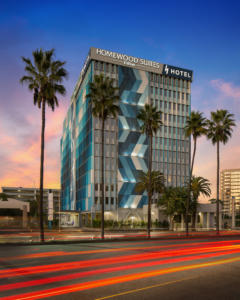 Adaptive re-use is starting to dominate hotel development. In the last year-and-a-half, R.D. Olson Construction says that the majority of its hotel projects have been major redevelopments or adaptive reuse projects. The construction company recently completed an adaptive re-use hotel project near LAX, converting a dilapidated office building into a dual-branded hotel.
“In the last three to five years, there has been a greater need for additional hotel rooms,” Bill Wilhelm, president of R.D. Olson Construction, tells GlobeSt.com. “So, there has been a lot of activity and a lot of hotel renovations. About 60% of our construction volume is in hospitality, and in the last year-and-a-half, we have seen a tremendous swing going from ground-up to adaptive reuse and major renovations. Before, we were running about 55% new, and now we have flipped it to where we are doing about 58% in adaptive reuse and the balance is in new construction.”
It makes sense that adaptive re-use has become popular for hotel projects. They are less expensive than ground-up construction and reserve character. Most importantly, however, they are much faster to build. “When you have an adaptive reuse opportunity, there are a lot of positives,” says Wilhelm. “One is the speed at which you can get a project up and running to where you have heads on beds, as we call it in the hotel industry. Two, when you look at the overall cost of construction for replacement cost, typically, you can find yourself a building that has a lot of character that you can use. It is more economical than doing ground-up construction.”
Adaptive re-use also helps to hedge against a potential downturn. Because the hotel is profitable more quickly, it can be a good tool for developers looking to get off the ground. “A lot of hotel developers and owners understand the demand, and it has become all about speed and how to get heads on beds,” adds Wilhelm. “We are trying to beat the industry when the industry starts to soften up. We are starting to see some of that. For the first time in six years, we have seen a decrease in new hotel starts. We are getting to the supply demand level where you are going to have to be careful with how many rooms you bring into a general area.”
The 12 story, 260,000-square-foot H Hotel adaptive re-use project took approximately 17 months to complete.
Adaptive re-use is starting to dominate hotel development. In the last year-and-a-half, R.D. Olson Construction says that the majority of its hotel projects have been major redevelopments or adaptive reuse projects. The construction company recently completed an adaptive re-use hotel project near LAX, converting a dilapidated office building into a dual-branded hotel.
“In the last three to five years, there has been a greater need for additional hotel rooms,” Bill Wilhelm, president of R.D. Olson Construction, tells GlobeSt.com. “So, there has been a lot of activity and a lot of hotel renovations. About 60% of our construction volume is in hospitality, and in the last year-and-a-half, we have seen a tremendous swing going from ground-up to adaptive reuse and major renovations. Before, we were running about 55% new, and now we have flipped it to where we are doing about 58% in adaptive reuse and the balance is in new construction.”
It makes sense that adaptive re-use has become popular for hotel projects. They are less expensive than ground-up construction and reserve character. Most importantly, however, they are much faster to build. “When you have an adaptive reuse opportunity, there are a lot of positives,” says Wilhelm. “One is the speed at which you can get a project up and running to where you have heads on beds, as we call it in the hotel industry. Two, when you look at the overall cost of construction for replacement cost, typically, you can find yourself a building that has a lot of character that you can use. It is more economical than doing ground-up construction.”
Adaptive re-use also helps to hedge against a potential downturn. Because the hotel is profitable more quickly, it can be a good tool for developers looking to get off the ground. “A lot of hotel developers and owners understand the demand, and it has become all about speed and how to get heads on beds,” adds Wilhelm. “We are trying to beat the industry when the industry starts to soften up. We are starting to see some of that. For the first time in six years, we have seen a decrease in new hotel starts. We are getting to the supply demand level where you are going to have to be careful with how many rooms you bring into a general area.”
The 12 story, 260,000-square-foot H Hotel adaptive re-use project took approximately 17 months to complete.Safety Concerns in The Construction Industry
November 21, 2017 – Globe St. - Carrie Rossenfeld
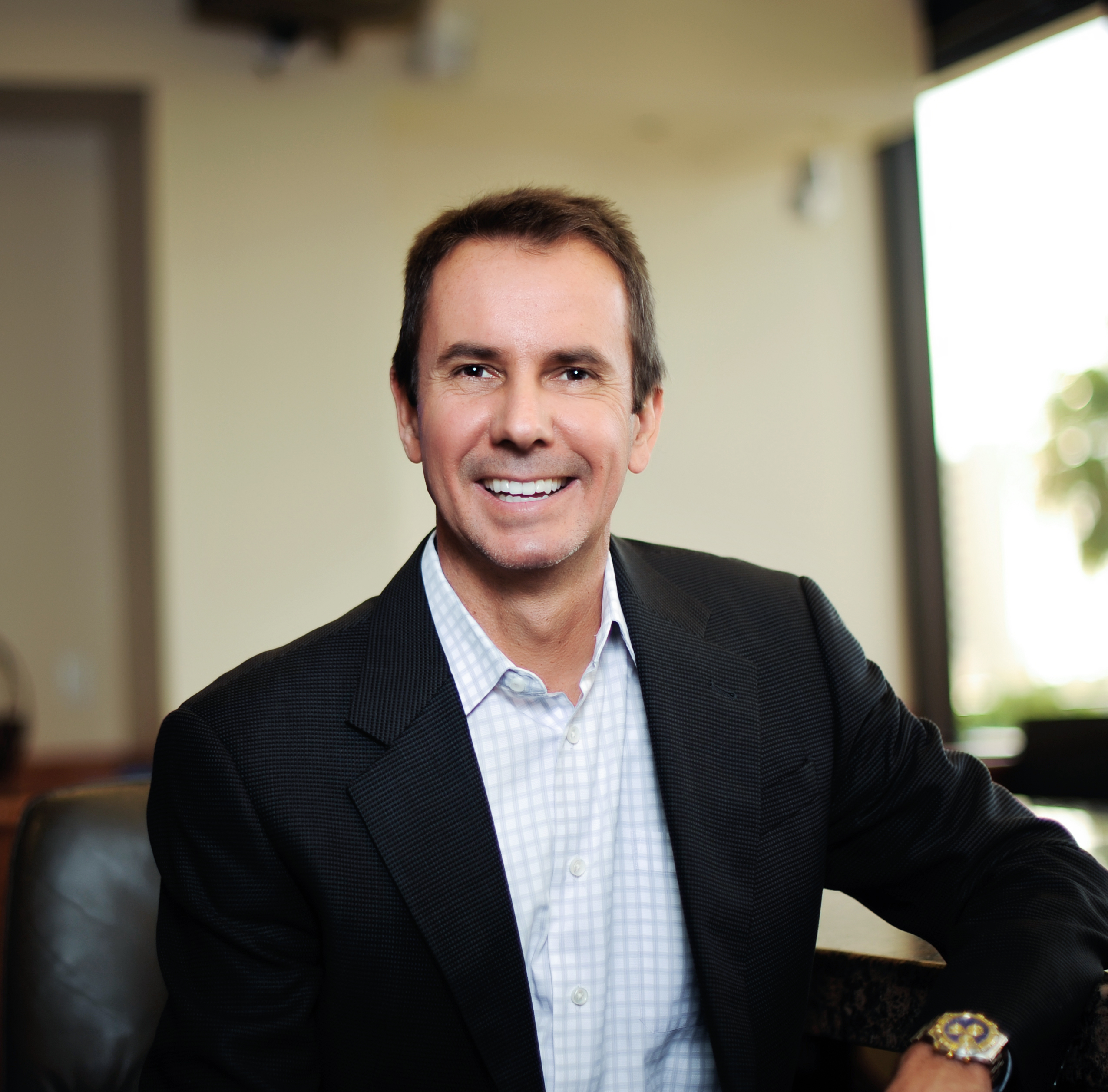 NEWPORT BEACH, CA—Safety is a culture, and educational programs need to be put in place to instill this culture and ensure that individuals in the construction industry are aware of their surroundings, R.D. Olson Construction’s president Bill Wilhelm tells GlobeSt.com. Implementing proper protocols from the start not only keeps workers safe, but also increases speed and productivity, he adds. We spoke with Wilhelm about how companies can improve their safety records and create a better working environment for employees and subcontractors.
GlobeSt.com: What are the top safety issues in the construction industry right now?
Wilhelm: The hottest issue in safety continues to be fall protection. Whether it is prioritizing the installation of safe scaffolding on the side of buildings or managing holes that go through the floor, potential causes for falls should always be closely monitored on construction sites.
Ear and eye protection are also some of the most critical safety concerns. Eyes are most vulnerable because they are the most exposed, and sparks from welding jobs, saws and other tools are common with any construction project. All individuals on a construction site need to wear proper hearing and eye protection to prevent injury.
GlobeSt.com: How can companies prevent safety issues from occurring?
Wilhelm: Safety is a culture, and educational programs need to be put in place to instill this culture and ensure individuals are aware of their surroundings. At R.D. Olson Construction, our employees are OSHA 30 certified, ensuring they have the training they need to promote our culture of safety. We have safety events and safety tailgates as often as once per week on job sites. Our safety directors also do full safety inspections on site at least once every other week. Safety is an ongoing part of our training and education, and is fostered across all levels—from management and employees to subcontractors and other project partners.
Regardless of the issue, safety as a whole is all about communication. On every site, you need to first identify the tasks that are taking place and what safety measures need to be implemented during every step of the construction process. Zoning, which involves cordoning off spaces when certain tasks are taking place to ensure those nearby aren’t at risk of being injured, is often part of our safety protocol.
GlobeSt.com: From a cost and productivity perspective, what are the benefits to implementing proper safety protocols and education programs from the start?
Wilhelm: Ensuring the safety of workers should always be the top priority, no matter the cost. However, the cost of implementing these protocols and education programs is often negligible and nearly always saves money in the long run. Safety issues, no matter how minor, can delay a project significantly, affect worker morale and lead to costly investigations. Implementing proper protocols and training from the start is the right thing to do, but it also has the added benefit of increasing speed and productivity.
GlobeSt.com: What else should readers know about this topic?
Wilhelm: An often overlooked, but extremely important, safety concern is exhaustion and general wear and tear on workers’ bodies. Tired workers present a very serious safety issue on job sites, and with an industry-wide talent shortage, it’s even more of a concern. Exhaustion can cause experienced workers to make simple, split-second mistakes that could be deadly. Companies can take preventative measures by ensuring that employees and subcontractors aren’t working too many hours and that the building schedule is realistic from the start.
NEWPORT BEACH, CA—Safety is a culture, and educational programs need to be put in place to instill this culture and ensure that individuals in the construction industry are aware of their surroundings, R.D. Olson Construction’s president Bill Wilhelm tells GlobeSt.com. Implementing proper protocols from the start not only keeps workers safe, but also increases speed and productivity, he adds. We spoke with Wilhelm about how companies can improve their safety records and create a better working environment for employees and subcontractors.
GlobeSt.com: What are the top safety issues in the construction industry right now?
Wilhelm: The hottest issue in safety continues to be fall protection. Whether it is prioritizing the installation of safe scaffolding on the side of buildings or managing holes that go through the floor, potential causes for falls should always be closely monitored on construction sites.
Ear and eye protection are also some of the most critical safety concerns. Eyes are most vulnerable because they are the most exposed, and sparks from welding jobs, saws and other tools are common with any construction project. All individuals on a construction site need to wear proper hearing and eye protection to prevent injury.
GlobeSt.com: How can companies prevent safety issues from occurring?
Wilhelm: Safety is a culture, and educational programs need to be put in place to instill this culture and ensure individuals are aware of their surroundings. At R.D. Olson Construction, our employees are OSHA 30 certified, ensuring they have the training they need to promote our culture of safety. We have safety events and safety tailgates as often as once per week on job sites. Our safety directors also do full safety inspections on site at least once every other week. Safety is an ongoing part of our training and education, and is fostered across all levels—from management and employees to subcontractors and other project partners.
Regardless of the issue, safety as a whole is all about communication. On every site, you need to first identify the tasks that are taking place and what safety measures need to be implemented during every step of the construction process. Zoning, which involves cordoning off spaces when certain tasks are taking place to ensure those nearby aren’t at risk of being injured, is often part of our safety protocol.
GlobeSt.com: From a cost and productivity perspective, what are the benefits to implementing proper safety protocols and education programs from the start?
Wilhelm: Ensuring the safety of workers should always be the top priority, no matter the cost. However, the cost of implementing these protocols and education programs is often negligible and nearly always saves money in the long run. Safety issues, no matter how minor, can delay a project significantly, affect worker morale and lead to costly investigations. Implementing proper protocols and training from the start is the right thing to do, but it also has the added benefit of increasing speed and productivity.
GlobeSt.com: What else should readers know about this topic?
Wilhelm: An often overlooked, but extremely important, safety concern is exhaustion and general wear and tear on workers’ bodies. Tired workers present a very serious safety issue on job sites, and with an industry-wide talent shortage, it’s even more of a concern. Exhaustion can cause experienced workers to make simple, split-second mistakes that could be deadly. Companies can take preventative measures by ensuring that employees and subcontractors aren’t working too many hours and that the building schedule is realistic from the start.R.D. Olson’s latest Aviation Inspired Hotel Project on the Local News.
November 6, 2017
R.D. Olson Construction Highlighted in the Orange County Business Journal
October 23, 2017
R.D. Olson Construction named Civic 50 Orange County Honoree
September 18, 2017
 The Orange County Business Journal (OCBJ) today announced the 50 most community-minded companies in Orange County. The Civic 50 Orange County, presented by the OCBJ and in partnership with OneOC, provides a local standard for superior citizenship and showcases how companies can use their time, skills, and other resources to improve the quality of life in the community where they do business. This is the first time the Civic 50, a national initiative of Points of Light, has been localized to a specific market.
Since 2012, the Civic 50 has recognized the 50 most community-minded companies in the nation each year as determined by an annual survey developed by True Impact. For Orange County, honorees were determined using True Impact's adapted national Civic 50 online survey that is independently administered and scored.
Companies were selected based upon four dimensions of their community engagement programs: investment, integration, institutionalization and impact. The Civic 50 OC honorees include businesses from three categories: small, medium and large (based on the company's number of local employees.
The inaugural Civic 50 )C Awards luncheon will be held October 19, 2017 at the Hotel Irvine featuring keynote speaker Matthew Emerizian, founder and CEO of Every Monday Matters. All 50 honorees will be recognized at the event , and five awards will be given in the following categories: small, medium and large company; emerging company; and legacy company.
The Orange County Business Journal (OCBJ) today announced the 50 most community-minded companies in Orange County. The Civic 50 Orange County, presented by the OCBJ and in partnership with OneOC, provides a local standard for superior citizenship and showcases how companies can use their time, skills, and other resources to improve the quality of life in the community where they do business. This is the first time the Civic 50, a national initiative of Points of Light, has been localized to a specific market.
Since 2012, the Civic 50 has recognized the 50 most community-minded companies in the nation each year as determined by an annual survey developed by True Impact. For Orange County, honorees were determined using True Impact's adapted national Civic 50 online survey that is independently administered and scored.
Companies were selected based upon four dimensions of their community engagement programs: investment, integration, institutionalization and impact. The Civic 50 OC honorees include businesses from three categories: small, medium and large (based on the company's number of local employees.
The inaugural Civic 50 )C Awards luncheon will be held October 19, 2017 at the Hotel Irvine featuring keynote speaker Matthew Emerizian, founder and CEO of Every Monday Matters. All 50 honorees will be recognized at the event , and five awards will be given in the following categories: small, medium and large company; emerging company; and legacy company.New Affordable Projects Help Residents Live Near Work
September 8, 2017 – Globe St. - Carrie Rossenfeld
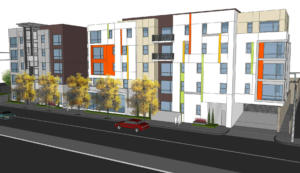 ORANGE COUNTY AND L.A. COUNTY RESIDENTS ARE INCREASINGLY FORCED TO MOVE OUT OF THE COUNTY IN WHICH THEY WORK DUE TO THE STATE’S HOUSING CRISIS, MAKING PROJECTS LIKE FULLERTON FAMILY HOUSING EVEN MORE NECESSARY, R.D. OLSON’S BILL WILHELM TELLS GLOBEST.COM.
FULLERTON, CA—Orange County and L.A. County residents are increasingly forced to move out of the county in which they work due to the state’s housing crisis, making projects like Fullerton Family Housing even more necessary, R.D. Olson Construction’s president Bill Wilhelm tells GlobeSt.com. The firm began construction last month on Related California’s 55-unit affordable-housing project here, its fourth such project, and completion is expected in May 2018.
The site is located at 335 East Santa Fe Ave., in close proximity to Downtown Fullerton and adjacent to the area’s train station. We spoke with Wilhelm about what makes this project unique and how affordable-housing construction compares to other multifamily projects.
GlobeSt.com: What features and amenities will Fullerton Family Housing include?
Wilhelm: Fullerton Family Housing will comprise 54 affordable units with one manager’s unit onsite. The five-story, 52,407-sqaure-foot complex will have studio, one-, two- and three-bedroom apartments available for rent, and includes a 24,000-square-foot parking garage. The walkability of the area offers a huge benefit for future residents, who will be able to walk to downtown Fullerton and access a train station adjacent to the site. The complex itself includes a courtyard, playground, BBQ area, on-site leasing office, bike storage room and laundry facilities. It is expected to be completed in summer of 2018.
GlobeSt.com: What need do affordable housing projects like this fill for Orange County residents?
Wilhelm: There is a full-fledged housing crisis in California, and this is especially the case in Orange and Los Angeles counties. Residents increasingly are forced to move out of the county in which they work. There is a severe shortage of affordable housing, and projects like these will allow more Orange County residents to be able to afford to stay in the area. Housing in prime, walkable locations with convenient access to public transportation gives residents more access to jobs, a better quality of life and allows them to spend more time with their families and less time commuting.
GlobeSt.com: Is there anything unique about affordable housing construction in comparison with other multifamily projects?
Wilhelm: Typically, affordable multifamily projects are in neighborhoods with smaller sites that can’t accommodate larger apartment complexes, which can present construction challenges. For this project, we are working with the railway, which is providing us with additional temporary storage space for building materials and setup. When building up to the property line, creative partnerships like this are essential to ensure construction is completed on time and under budget.
Additionally, affordable-housing complexes typically are built with easy access to public transportation to accommodate families who may not have access to their own transportation. Proximity to a train station is a big reason we chose the site for Fullerton Family Housing. This contributes to a lessened need for parking spaces, which maximizes the number of units that can be built on the smaller sites. An affordable-housing site could have 80 units, but only 40 parking spaces.
GlobeSt.com: How does this project fit into R.D. Olson Construction’s multifamily portfolio?
Wilhelm: This project is R.D. Olson Construction’s fourth affordable complex, and adds to our extensive multifamily portfolio in California. Our multifamily work spans many market sectors, and includes senior housing, live/work townhomes, luxury apartments, condos, student housing and more. As far as affordable housing, our most recent project was the 180-
unit Village at Calabasas, which was completed in 2016.
ORANGE COUNTY AND L.A. COUNTY RESIDENTS ARE INCREASINGLY FORCED TO MOVE OUT OF THE COUNTY IN WHICH THEY WORK DUE TO THE STATE’S HOUSING CRISIS, MAKING PROJECTS LIKE FULLERTON FAMILY HOUSING EVEN MORE NECESSARY, R.D. OLSON’S BILL WILHELM TELLS GLOBEST.COM.
FULLERTON, CA—Orange County and L.A. County residents are increasingly forced to move out of the county in which they work due to the state’s housing crisis, making projects like Fullerton Family Housing even more necessary, R.D. Olson Construction’s president Bill Wilhelm tells GlobeSt.com. The firm began construction last month on Related California’s 55-unit affordable-housing project here, its fourth such project, and completion is expected in May 2018.
The site is located at 335 East Santa Fe Ave., in close proximity to Downtown Fullerton and adjacent to the area’s train station. We spoke with Wilhelm about what makes this project unique and how affordable-housing construction compares to other multifamily projects.
GlobeSt.com: What features and amenities will Fullerton Family Housing include?
Wilhelm: Fullerton Family Housing will comprise 54 affordable units with one manager’s unit onsite. The five-story, 52,407-sqaure-foot complex will have studio, one-, two- and three-bedroom apartments available for rent, and includes a 24,000-square-foot parking garage. The walkability of the area offers a huge benefit for future residents, who will be able to walk to downtown Fullerton and access a train station adjacent to the site. The complex itself includes a courtyard, playground, BBQ area, on-site leasing office, bike storage room and laundry facilities. It is expected to be completed in summer of 2018.
GlobeSt.com: What need do affordable housing projects like this fill for Orange County residents?
Wilhelm: There is a full-fledged housing crisis in California, and this is especially the case in Orange and Los Angeles counties. Residents increasingly are forced to move out of the county in which they work. There is a severe shortage of affordable housing, and projects like these will allow more Orange County residents to be able to afford to stay in the area. Housing in prime, walkable locations with convenient access to public transportation gives residents more access to jobs, a better quality of life and allows them to spend more time with their families and less time commuting.
GlobeSt.com: Is there anything unique about affordable housing construction in comparison with other multifamily projects?
Wilhelm: Typically, affordable multifamily projects are in neighborhoods with smaller sites that can’t accommodate larger apartment complexes, which can present construction challenges. For this project, we are working with the railway, which is providing us with additional temporary storage space for building materials and setup. When building up to the property line, creative partnerships like this are essential to ensure construction is completed on time and under budget.
Additionally, affordable-housing complexes typically are built with easy access to public transportation to accommodate families who may not have access to their own transportation. Proximity to a train station is a big reason we chose the site for Fullerton Family Housing. This contributes to a lessened need for parking spaces, which maximizes the number of units that can be built on the smaller sites. An affordable-housing site could have 80 units, but only 40 parking spaces.
GlobeSt.com: How does this project fit into R.D. Olson Construction’s multifamily portfolio?
Wilhelm: This project is R.D. Olson Construction’s fourth affordable complex, and adds to our extensive multifamily portfolio in California. Our multifamily work spans many market sectors, and includes senior housing, live/work townhomes, luxury apartments, condos, student housing and more. As far as affordable housing, our most recent project was the 180-
unit Village at Calabasas, which was completed in 2016.Record Number Of California Hotel Rooms Open in First Half of 2017
July 18, 2017 – Orange County Register
 The number of new hotels that opened in California increased 53 percent in the first half of 2017 and there were 15 percent more hotels in development and 6 percent more under construction vs. the same period in 2016, according to an Atlas Hospitality Group study.
“This is a record number of hotel rooms that have opened in the first six months of the year,” said Alan Reay, president of Irvine-based Atlas.
Twenty-six hotels, with 4,730 rooms, opened in the first half of 2017 vs. 17 hotels in the same period of 2016.
Reay said many hotels are being built now because the price of buying and renovating older hotels is high, that it is more attractive to build a new hotel, construction financing and loans are readily available and there have been six years of revenue increases.
In Orange County three hotels with 461 rooms opened during the first half of the year.
Homewood Suites by Hilton Irvine John Wayne Airport: The 161-room hotel opened this winter. It offers studio, one- and two- bedroom suites. Each has a fully equipped kitchen. The hotel has a fitness room, pool, business center and meeting rooms.
The project was Irvine-based R.D. Olson Construction’s first partnership with hotel management and development company DKN Hotels, also based in Irvine.
The number of new hotels that opened in California increased 53 percent in the first half of 2017 and there were 15 percent more hotels in development and 6 percent more under construction vs. the same period in 2016, according to an Atlas Hospitality Group study.
“This is a record number of hotel rooms that have opened in the first six months of the year,” said Alan Reay, president of Irvine-based Atlas.
Twenty-six hotels, with 4,730 rooms, opened in the first half of 2017 vs. 17 hotels in the same period of 2016.
Reay said many hotels are being built now because the price of buying and renovating older hotels is high, that it is more attractive to build a new hotel, construction financing and loans are readily available and there have been six years of revenue increases.
In Orange County three hotels with 461 rooms opened during the first half of the year.
Homewood Suites by Hilton Irvine John Wayne Airport: The 161-room hotel opened this winter. It offers studio, one- and two- bedroom suites. Each has a fully equipped kitchen. The hotel has a fitness room, pool, business center and meeting rooms.
The project was Irvine-based R.D. Olson Construction’s first partnership with hotel management and development company DKN Hotels, also based in Irvine.R.D. Olson Construction Named as One of the Best Places to Work in Orange County for the Second Year in A Row
June 29, 2017
 We were just notified that we have once again made the list of Best Places to Work in Orange County. We have attempted to receive the award twice and have successfully made the list both times, so that speaks volumes to the atmosphere that all our associates try to cultivate within the walls of our office as well as out in the field on our project sites. The incredible positivity that all our associates possess is a testament to the entrepreneurial spirit that drives our business forward. When our associates are able to make decisions for the way they handle their job and are rewarded consistently for their initiative, it makes for a truly great and dynamic corporate environment.
We were just notified that we have once again made the list of Best Places to Work in Orange County. We have attempted to receive the award twice and have successfully made the list both times, so that speaks volumes to the atmosphere that all our associates try to cultivate within the walls of our office as well as out in the field on our project sites. The incredible positivity that all our associates possess is a testament to the entrepreneurial spirit that drives our business forward. When our associates are able to make decisions for the way they handle their job and are rewarded consistently for their initiative, it makes for a truly great and dynamic corporate environment.What Determines If Hotel Projects Move Forward?
March 3, 2017
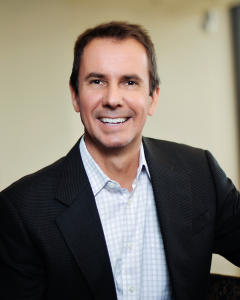 IRVINE, CA—Timing is a major issue in hotel projects as this point; if a project is not far enough along in drawings, permits, etc., it may not make it off the ground, R.D. Olson Construction’s president Bill Wilhelm tells GlobeSt.com. The firm, a successful builder of hotel properties in California recently completed construction on Homewood Suites by Hilton Irvine/John Wayne Airport. The ground-up project marks the firm’s first partnership with Irvine-based hotel management and development company DKN Hotels.
The four-story, 161-room hotel is located in the Irvine business and industrial district and is close to Orange County shopping centers the District, South Coast Plaza and Fashion Island. The hotel represents the firm’s third completed project in Irvine, with the Irvine Spectrum Marriott currently underway.
The 126,000-square-foot hotel boasts studios and one- and two-bedroom suites with 42‑inch HDTVs and kitchens that include a full-size refrigerator, microwave, stove and dishwasher. The property’s outdoor amenities include a pool and spa, fire pit, BBQ grills and a sports court with options for basketball, volleyball, badminton and smashball.
R.D. Olson also recently completed work on the 174-room Country Inns & Suites by Carlson in the Anaheim Resort District and the 200-room Residence Inn by Marriott hotel in Wailea, Maui, HI, the first family-centric hotel in Wailea. Other recent completions include Paséa Hotel & Spa in Huntington Beach, CA, the 144-room Residence Inn by Marriott in Old Town Pasadena, CA, and the 94-room Hampton Inn & Suites in Glendale, CA. The firm is currently building additional regional hospitality projects including the 130-room Lido House Hotel resort in Newport Beach, CA; the 271-room full-service Irvine Spectrum Marriott in Irvine, CA; and the 118-room Residence Inn by Marriott Santa Barbara/Goleta in Goleta, CA.
We spoke with Wilhelm about the Homewood Suites project, hotel-development trends he is noticing in Orange County and takeaways from ALIS, which he recently attended.
GlobeSt.com: Why was this project a good fit for the airport market?
Wilhelm: It is in kind of a secondary airport to the market, and based on its vicinity to the airport, will allow it to be a strong secondary feeder to the airport market. It’s not directly at the airport, but a spit throw away. It has easy access, and it’s in an area with a lot of corporate business, more industrial type of business. It’s a great location: off the beaten path, but with great geographic identification. Also, Tustin’s Marine Corps Air Station is still going thru major discussions—what will they do and what will happen. It’s the first steps to what will eventually be promising development in that area.
GlobeSt.com: What hotel-development trends are you noticing in Orange County?
Wilhelm: There are two trends. One is that Orange County itself has had so much growth take place—both residential growth and continued enhancement of corporate growth. The business sector and the growth of tourism, Disneyland and that whole market has been strong. Disneyland continues to do what the Irvine Spectrum area is doing: constantly challenge themselves by asking, “What are we current with what are the general population’s needs? What can we offer our guests in terms of more experiences? They’re always thinking outside the box on enhancements. Irvine Spectrum, too, constantly challenges itself as far as what the needs are today. In the Spectrum area, some retail pieces have come and gone, and they’re stepping up more food-service providers. They’ve done a good job of putting great restaurants in and entertainment so people want to hang out there—you can have a great dinner and people watch. You have the tourist side of it and also the corporate business side of it. When you look at the occupancy and rental part of it in the Orange County market, so many things are taking place where companies are repositioning and expanding based on the opportunities.
The office side has also picked up. But from a hospitality perspective, Orange County is an area that has done well and has additional growth opportunities because you have multiple feeders: tourism, corporate and residential.
GlobeSt.com: What trends did you notice at this year’s ALIS conference?
Wilhelm: The overall trend is one of a little bit of caution. Predictions still show a very strong year, 2017 going into 2018; predictions are that they will be equivalent to 2016, and there may be a little bit of growth. There are a number of projects that are in planning, under construction and in development.
I look at timing and finance. I really want to understand where they are in the timing cycle: drawings, permits, where are they in their financing? There’s a concern that somewhere down the road, we will start to see a few deals not go forward because of timing. We’re also seeing some developers that recognize that. Everyone is looking forward and trying to make that mad dash to the finish line; there’s a lot of adaptive reuse where the individual can get their hands on a property and be out there in renovation mode, and then 12 to 14 months later, they now have heads on beds; whereas, a new property could take 14 to 24 months or longer. A lot of it is geographic, too—the market will play a stronghold, and primary markets will always do well.
I’ve heard the saying, “California isn’t overbuilt; it’s under-demolished.” From a hotel perspective that’s so true. There are so many older properties, but what will it take to bring a 25-year-old property to current standards. I think in today’s world, everyone’s willing to pay a few more dollars for a fresh, new property that provides the experience that people are seeking. You want to be out and engaged with socialization around you, whether out by pool or in the lobby. There’s a lot of business taking place in common areas among people who may not even be guests of the hotel, but are using the business-area environment. It’s a way to do business to have a cup of coffee and have a meeting.
GlobeSt.com: What does your firm currently have in the pipeline?
Wilhelm: We’re busy, but always looking for great opportunities. We have some nice projects under construction today in hospitality, including new ground-up hotels and adaptive reuse that converts office to hotels. We’re doing a refresh of Palomar Hotel in Beverly Hills, CA—we’re refurbishing the lobby, bar area and amenities. We’re also in the time-share market and the education market. Among all those markets, I still see another 18 months of active work with some pretty exciting projects./p
IRVINE, CA—Timing is a major issue in hotel projects as this point; if a project is not far enough along in drawings, permits, etc., it may not make it off the ground, R.D. Olson Construction’s president Bill Wilhelm tells GlobeSt.com. The firm, a successful builder of hotel properties in California recently completed construction on Homewood Suites by Hilton Irvine/John Wayne Airport. The ground-up project marks the firm’s first partnership with Irvine-based hotel management and development company DKN Hotels.
The four-story, 161-room hotel is located in the Irvine business and industrial district and is close to Orange County shopping centers the District, South Coast Plaza and Fashion Island. The hotel represents the firm’s third completed project in Irvine, with the Irvine Spectrum Marriott currently underway.
The 126,000-square-foot hotel boasts studios and one- and two-bedroom suites with 42‑inch HDTVs and kitchens that include a full-size refrigerator, microwave, stove and dishwasher. The property’s outdoor amenities include a pool and spa, fire pit, BBQ grills and a sports court with options for basketball, volleyball, badminton and smashball.
R.D. Olson also recently completed work on the 174-room Country Inns & Suites by Carlson in the Anaheim Resort District and the 200-room Residence Inn by Marriott hotel in Wailea, Maui, HI, the first family-centric hotel in Wailea. Other recent completions include Paséa Hotel & Spa in Huntington Beach, CA, the 144-room Residence Inn by Marriott in Old Town Pasadena, CA, and the 94-room Hampton Inn & Suites in Glendale, CA. The firm is currently building additional regional hospitality projects including the 130-room Lido House Hotel resort in Newport Beach, CA; the 271-room full-service Irvine Spectrum Marriott in Irvine, CA; and the 118-room Residence Inn by Marriott Santa Barbara/Goleta in Goleta, CA.
We spoke with Wilhelm about the Homewood Suites project, hotel-development trends he is noticing in Orange County and takeaways from ALIS, which he recently attended.
GlobeSt.com: Why was this project a good fit for the airport market?
Wilhelm: It is in kind of a secondary airport to the market, and based on its vicinity to the airport, will allow it to be a strong secondary feeder to the airport market. It’s not directly at the airport, but a spit throw away. It has easy access, and it’s in an area with a lot of corporate business, more industrial type of business. It’s a great location: off the beaten path, but with great geographic identification. Also, Tustin’s Marine Corps Air Station is still going thru major discussions—what will they do and what will happen. It’s the first steps to what will eventually be promising development in that area.
GlobeSt.com: What hotel-development trends are you noticing in Orange County?
Wilhelm: There are two trends. One is that Orange County itself has had so much growth take place—both residential growth and continued enhancement of corporate growth. The business sector and the growth of tourism, Disneyland and that whole market has been strong. Disneyland continues to do what the Irvine Spectrum area is doing: constantly challenge themselves by asking, “What are we current with what are the general population’s needs? What can we offer our guests in terms of more experiences? They’re always thinking outside the box on enhancements. Irvine Spectrum, too, constantly challenges itself as far as what the needs are today. In the Spectrum area, some retail pieces have come and gone, and they’re stepping up more food-service providers. They’ve done a good job of putting great restaurants in and entertainment so people want to hang out there—you can have a great dinner and people watch. You have the tourist side of it and also the corporate business side of it. When you look at the occupancy and rental part of it in the Orange County market, so many things are taking place where companies are repositioning and expanding based on the opportunities.
The office side has also picked up. But from a hospitality perspective, Orange County is an area that has done well and has additional growth opportunities because you have multiple feeders: tourism, corporate and residential.
GlobeSt.com: What trends did you notice at this year’s ALIS conference?
Wilhelm: The overall trend is one of a little bit of caution. Predictions still show a very strong year, 2017 going into 2018; predictions are that they will be equivalent to 2016, and there may be a little bit of growth. There are a number of projects that are in planning, under construction and in development.
I look at timing and finance. I really want to understand where they are in the timing cycle: drawings, permits, where are they in their financing? There’s a concern that somewhere down the road, we will start to see a few deals not go forward because of timing. We’re also seeing some developers that recognize that. Everyone is looking forward and trying to make that mad dash to the finish line; there’s a lot of adaptive reuse where the individual can get their hands on a property and be out there in renovation mode, and then 12 to 14 months later, they now have heads on beds; whereas, a new property could take 14 to 24 months or longer. A lot of it is geographic, too—the market will play a stronghold, and primary markets will always do well.
I’ve heard the saying, “California isn’t overbuilt; it’s under-demolished.” From a hotel perspective that’s so true. There are so many older properties, but what will it take to bring a 25-year-old property to current standards. I think in today’s world, everyone’s willing to pay a few more dollars for a fresh, new property that provides the experience that people are seeking. You want to be out and engaged with socialization around you, whether out by pool or in the lobby. There’s a lot of business taking place in common areas among people who may not even be guests of the hotel, but are using the business-area environment. It’s a way to do business to have a cup of coffee and have a meeting.
GlobeSt.com: What does your firm currently have in the pipeline?
Wilhelm: We’re busy, but always looking for great opportunities. We have some nice projects under construction today in hospitality, including new ground-up hotels and adaptive reuse that converts office to hotels. We’re doing a refresh of Palomar Hotel in Beverly Hills, CA—we’re refurbishing the lobby, bar area and amenities. We’re also in the time-share market and the education market. Among all those markets, I still see another 18 months of active work with some pretty exciting projects./pR.D. Olson Contributes Insight to the Wall Street Journal
February 22, 2017
 Immigrant Crackdown Worries Food and Construction Industries
By Jacob Bunge, Heather Haddon, and Eric Morath
Memos issued by the Trump administration on Tuesday said millions of people living illegally in the U.S. are subject to deportation and called on local authorities to enforce immigration laws.
The announcement set many in the food business in particular on edge. “We’re preparing our members as best we can,” said Jim Bogart, president of the Grower-Shipper Association of Central California, which represents producers of vegetables, mushrooms and grapes.
An executive order signed by President Donald Trump last month banning entry to the U.S. from seven Muslim-majority countries for at least 90 days over terrorism concerns has been held up by courts.
A White House official on Wednesday confirmed that it wouldn’t issue its revised executive order on immigration travel restrictions until next week. The administration had previously said it would release a new order this week.
Administration officials suggested the new executive order would have a similar aim as the previous one. In an interview on Fox News on Tuesday, policy adviser Stephen Miller said, “Fundamentally you’re going to have the same basic policy outcome for the country.”
The agriculture and construction industries have relied on immigrants for decades to do tough, low-paying jobs U.S. citizens often avoid, from picking berries to slicing up hogs to erecting framing for houses. Many of these workers are undocumented.
“Business is business, and whether it’s the farming industry or the construction industry, we already have a resource issue,” said Bill Wilhelm, president of R.D. Olson Construction in Irvine, Calif., which specializes in hotel construction. “You already have a shortage of documented individuals. So if you have fewer and fewer undocumented, at the end of the day it’s going to have an impact on projects.”
Foreign-born workers make up about three-quarters of the roughly 1.1 million workers on U.S. farms, and nearly half aren’t legally authorized to work, according to the U.S. Department of Agriculture. In the construction industry, 13% of workers in 2014 were undocumented, according to data from the Pew Research Center, along with about 9% of workers in the leisure and hospitality industry, which includes restaurants.
Labor-strapped American employers increasingly rely on immigrants—including those in the U.S. illegally—to counter the trend of an aging native-born population. If millions of illegal immigrants were deported, “you would have massive labor shortages,” said University of Michigan labor economist Donald Grimes.
Department of Homeland Security officials said their limited resources mean they would focus on immigrants who pose a public-safety risk. But they also said immigrants aren’t exempt from deportation just because they don’t fall into a priority group. “The enforcement priorities are criminal aliens as well as those who pose national-security and public-safety threats,” said White House spokesman Michael Short on Wednesday.
In Fresno, Calif., immigration attorney Camille Cook said she is helping to organize rapid-response teams for the area’s farmworkers, many of whom are undocumented immigrants from Mexico. Those teams aim to advise dairy and crop workers on their rights if immigration authorities show up on their doorsteps, she said.
Not all of the changes—like expedited removals for immigrants—will take effect immediately. Carol Meylan, director of Intra-Agency Programs at Catholic Charities of Los Angeles, said she expected most effects of the executive orders wouldn’t be felt for several months as the government hires more border-patrol agents and puts new procedures in place.
Still, Ms. Meylan said, “with 5,000 more border-patrol officers [planned], we’re anticipating there’s going to be a big change.”
Mr. Wilhelm of R.D. Olson Construction said he is waiting to see the impact of the government’s moves but expects that stepped-up deportations would affect all operators in his industry.
Immigrants wait for work last month at a day-labor pickup site in Stamford, Conn. The city has an official zone for employers to pick up such workers.
The Grower-Shipper Association, based in Salinas, Calif., has issued recommendations since last month about how to respond to immigration raids, outlining workers’ rights and current immigration policies in coordination with other industry groups. Mr. Bogart said half his days now are dedicated to calls with producers and lawmakers to discuss immigration issues.
Others are already seeing fallout from the tougher tone from the Trump administration. Paul Halderson said his 1,200-cow dairy farm near La Crosse, Wis., was left short-handed after losing a handful of immigrant employees in recent weeks, who opted to return to Mexico.
While Mr. Halderson said his employees all have legal standing to work in the U.S., some have worried about family members and the general climate for immigrants. “It is unrealistic to believe that dairy farming can continue as it is without the Mexican employees,” said Mr. Halderson.
Harold McClarty, co-founder of HMC Farms in California’s Fresno County, estimated the crackdown could lead to millions of dollars in losses for his stone-fruit and table-grape operation.
The restaurant industry, which also relies heavily on foreign-born workers, has long used E-Verify, a federal worker-screening program that allows employers to check employees’ legal status online.
“We have let our franchisees know of the increased activity and used it as an opportunity to remind them…that all franchisees use E-Verify,” said a spokeswoman for Dunkin Brands Group Inc., owner of Dunkin’ Donuts, which was an early adopter of E-Verify.
—Chris Kirkham, Julie Jargon and Ian Lovett contributed to this article.
Immigrant Crackdown Worries Food and Construction Industries
By Jacob Bunge, Heather Haddon, and Eric Morath
Memos issued by the Trump administration on Tuesday said millions of people living illegally in the U.S. are subject to deportation and called on local authorities to enforce immigration laws.
The announcement set many in the food business in particular on edge. “We’re preparing our members as best we can,” said Jim Bogart, president of the Grower-Shipper Association of Central California, which represents producers of vegetables, mushrooms and grapes.
An executive order signed by President Donald Trump last month banning entry to the U.S. from seven Muslim-majority countries for at least 90 days over terrorism concerns has been held up by courts.
A White House official on Wednesday confirmed that it wouldn’t issue its revised executive order on immigration travel restrictions until next week. The administration had previously said it would release a new order this week.
Administration officials suggested the new executive order would have a similar aim as the previous one. In an interview on Fox News on Tuesday, policy adviser Stephen Miller said, “Fundamentally you’re going to have the same basic policy outcome for the country.”
The agriculture and construction industries have relied on immigrants for decades to do tough, low-paying jobs U.S. citizens often avoid, from picking berries to slicing up hogs to erecting framing for houses. Many of these workers are undocumented.
“Business is business, and whether it’s the farming industry or the construction industry, we already have a resource issue,” said Bill Wilhelm, president of R.D. Olson Construction in Irvine, Calif., which specializes in hotel construction. “You already have a shortage of documented individuals. So if you have fewer and fewer undocumented, at the end of the day it’s going to have an impact on projects.”
Foreign-born workers make up about three-quarters of the roughly 1.1 million workers on U.S. farms, and nearly half aren’t legally authorized to work, according to the U.S. Department of Agriculture. In the construction industry, 13% of workers in 2014 were undocumented, according to data from the Pew Research Center, along with about 9% of workers in the leisure and hospitality industry, which includes restaurants.
Labor-strapped American employers increasingly rely on immigrants—including those in the U.S. illegally—to counter the trend of an aging native-born population. If millions of illegal immigrants were deported, “you would have massive labor shortages,” said University of Michigan labor economist Donald Grimes.
Department of Homeland Security officials said their limited resources mean they would focus on immigrants who pose a public-safety risk. But they also said immigrants aren’t exempt from deportation just because they don’t fall into a priority group. “The enforcement priorities are criminal aliens as well as those who pose national-security and public-safety threats,” said White House spokesman Michael Short on Wednesday.
In Fresno, Calif., immigration attorney Camille Cook said she is helping to organize rapid-response teams for the area’s farmworkers, many of whom are undocumented immigrants from Mexico. Those teams aim to advise dairy and crop workers on their rights if immigration authorities show up on their doorsteps, she said.
Not all of the changes—like expedited removals for immigrants—will take effect immediately. Carol Meylan, director of Intra-Agency Programs at Catholic Charities of Los Angeles, said she expected most effects of the executive orders wouldn’t be felt for several months as the government hires more border-patrol agents and puts new procedures in place.
Still, Ms. Meylan said, “with 5,000 more border-patrol officers [planned], we’re anticipating there’s going to be a big change.”
Mr. Wilhelm of R.D. Olson Construction said he is waiting to see the impact of the government’s moves but expects that stepped-up deportations would affect all operators in his industry.
Immigrants wait for work last month at a day-labor pickup site in Stamford, Conn. The city has an official zone for employers to pick up such workers.
The Grower-Shipper Association, based in Salinas, Calif., has issued recommendations since last month about how to respond to immigration raids, outlining workers’ rights and current immigration policies in coordination with other industry groups. Mr. Bogart said half his days now are dedicated to calls with producers and lawmakers to discuss immigration issues.
Others are already seeing fallout from the tougher tone from the Trump administration. Paul Halderson said his 1,200-cow dairy farm near La Crosse, Wis., was left short-handed after losing a handful of immigrant employees in recent weeks, who opted to return to Mexico.
While Mr. Halderson said his employees all have legal standing to work in the U.S., some have worried about family members and the general climate for immigrants. “It is unrealistic to believe that dairy farming can continue as it is without the Mexican employees,” said Mr. Halderson.
Harold McClarty, co-founder of HMC Farms in California’s Fresno County, estimated the crackdown could lead to millions of dollars in losses for his stone-fruit and table-grape operation.
The restaurant industry, which also relies heavily on foreign-born workers, has long used E-Verify, a federal worker-screening program that allows employers to check employees’ legal status online.
“We have let our franchisees know of the increased activity and used it as an opportunity to remind them…that all franchisees use E-Verify,” said a spokeswoman for Dunkin Brands Group Inc., owner of Dunkin’ Donuts, which was an early adopter of E-Verify.
—Chris Kirkham, Julie Jargon and Ian Lovett contributed to this article.Four R.D. Olson Projects Mentioned and Honored in California Meeting and Events Magazine
February 17, 2017 – California Meetings & Events
 It's remarkable to have four of our recent projects mentioned and honored in California Meeting & Events Magazine's Winter Issue. The anticipation for the Irvine Spectrum Marriott (page 29) and Lido House Hotel (page 44) is increasing, while Pasea Hotel & Spa is named "Best New Venue" and W Hotel is named "Best Renovation" (page 39). Check all the full stories here.
It's remarkable to have four of our recent projects mentioned and honored in California Meeting & Events Magazine's Winter Issue. The anticipation for the Irvine Spectrum Marriott (page 29) and Lido House Hotel (page 44) is increasing, while Pasea Hotel & Spa is named "Best New Venue" and W Hotel is named "Best Renovation" (page 39). Check all the full stories here.CEO, Bob Olson, recognized in the Orange County Business Journal’s OC500
November 15, 2016 – Orange County Business Journal

Build Magazine recognizes R.D. Olson Construction as Most Innovative General Contractor and Most Innovative Hotel/Resort Project for the Pasea Hotel & Spa
October 26, 2016
More public spaces. Catering to international visitors. Hotels with local flair.
October 23, 2016 – Orange County Register
R.D. Olson Construction Named as One of the Best Places to Work in Orange County
July 25, 2016 – Orange County Business Journal
 R.D. Olson Construction is incredibly proud to have been recognized as one of the top workplaces in Orange County for 2016. This achievement is attributed to our outstanding staff who go above and beyond to work as a team and stay connected as not just associates but as a family united. The dedication of our team members is something that drives the entire success of our business and every individual within the organization makes it a pleasure for every other associate. Hard work can also be fun, and at R.D. Olson we constantly strive to make our environment as enjoyable as possible.
R.D. Olson Construction is incredibly proud to have been recognized as one of the top workplaces in Orange County for 2016. This achievement is attributed to our outstanding staff who go above and beyond to work as a team and stay connected as not just associates but as a family united. The dedication of our team members is something that drives the entire success of our business and every individual within the organization makes it a pleasure for every other associate. Hard work can also be fun, and at R.D. Olson we constantly strive to make our environment as enjoyable as possible.Building a Gem
July 14, 2016 – Construction Today
 The hotel will be a good fit in the Irvine Spectrum community, Wilhelm says. “It’s a property that will be associated with a number of different venues in the area, serving the local office, residential and retail communities,” he says. “It will make a great splash and fill a void in the hospitality offerings in that area.”
The hotel’s amenities and meeting space allow ample opportunity for both work and leisure activities, Wilhelm adds, which is especially relevant given the property’s location nearby several major corporation headquarters and central Orange County housing and shopping. “The property allows for the flexibility to create environments that allow guests and visitors to accomplish their daily work and host corporate events. At the same time, if the family wants to tag along on a business trip, they can enjoy the best of what the full-service facility has to offer as well as nearby amenities,” he states.
Shared Values
R.D. Olson Construction’s sister company, R.D. Olson Development, is developing the project. This is not the duo’s first hotel for Marriott International in Irvine, Wilhelm says. “Irvine Spectrum Marriott is located adjacent to a Courtyard by Marriott that we constructed,” he says. “Those two properties will perform well for Marriott and provide business travelers and visitors with a variety of options.”
R.D. Olson Construction has much in common with Marriott, Wilhelm says. “Both companies really care about people and the end-user experience, and also continuously aim to be at the forefront of our respective industries,” he says.
On the Cutting-Edge
R.D. Olson Construction is building Irvine Spectrum Marriott with sustainability in mind, Wilhelm says. “With the new Title 24 credits in California emphasizing construction ‘greenness,’ more attention goes into every detail such as the electrical system and the way it monitors different circuitries,” he says. “By examining these back-end systems from the beginning, we can make sure that the property performs in a more environmentally-friendly way without placing large burdens on the end-user.”
Such sustainable features will make Irvine Spectrum Marriott an upgrade from other hotels, Wilhelm adds. “It is definitely a property that will be a cut above the rest,” he says. “It is a true reflection of how many hotel brands are continuously upgrading their brand on a yearly basis.”
The hotel’s design is still being developed despite the construction process being underway, something to which R.D. Olson Construction is accustomed. “We’re part of that frontier team, out there working with ownership and Marriott on finishes, textures, colors and other elements that will give this property the ‘wow factor’ it needs to be cutting-edge and exceed guest expectations,” he says.
This design/build approach has become more common in the travel industry, as hotels want to stay in tune with what is popular with guests. “In about 80 percent of hotels that R.D. Olson builds, we’re in the trenches during the design phase, trying to make the concept the most successful it can be,” Wilhelm says.
In the case of Irvine Spectrum Marriott, the interior design will celebrate the rich history of the Irvine Ranch, in keeping with R.D. Olson’s dedication to paying homage to the communities in which its hotel projects are located.
Seeing Success
Based in Irvine, R.D. Olson Construction started operations in 1979 and provides general contracting and construction management services for clients nationally. Wilhelm, who joined the firm 22 years ago, credits its success to its people. “We’ve got the best in the industry, bar none,” he says.
Finding those people can sometimes be difficult, he admits. During the recession, “The construction industry lost a number of qualified craftsmen,” he recalls. “Some retired and some went into other industries.”
Like many, it was a challenge for R.D. Olson Construction to make up for the lost labor. However, the company “does a good job of managing that challenge,” he asserts. “We have strong relationships with our subcontractor community.”
He sees a strong future for the company, which has learned many lessons over the past 37 years. “We have always performed well during tough times,” Wilhelm says. “Because of our vast experience and industry knowledge, we’re able to anticipate downturns, and make adjustments accordingly.
“The company’s success and growth is attributed to the strong partnerships we have established with our customers,” he asserts. “There is a direct correlation between our customer’s growth and ours.”
The hotel will be a good fit in the Irvine Spectrum community, Wilhelm says. “It’s a property that will be associated with a number of different venues in the area, serving the local office, residential and retail communities,” he says. “It will make a great splash and fill a void in the hospitality offerings in that area.”
The hotel’s amenities and meeting space allow ample opportunity for both work and leisure activities, Wilhelm adds, which is especially relevant given the property’s location nearby several major corporation headquarters and central Orange County housing and shopping. “The property allows for the flexibility to create environments that allow guests and visitors to accomplish their daily work and host corporate events. At the same time, if the family wants to tag along on a business trip, they can enjoy the best of what the full-service facility has to offer as well as nearby amenities,” he states.
Shared Values
R.D. Olson Construction’s sister company, R.D. Olson Development, is developing the project. This is not the duo’s first hotel for Marriott International in Irvine, Wilhelm says. “Irvine Spectrum Marriott is located adjacent to a Courtyard by Marriott that we constructed,” he says. “Those two properties will perform well for Marriott and provide business travelers and visitors with a variety of options.”
R.D. Olson Construction has much in common with Marriott, Wilhelm says. “Both companies really care about people and the end-user experience, and also continuously aim to be at the forefront of our respective industries,” he says.
On the Cutting-Edge
R.D. Olson Construction is building Irvine Spectrum Marriott with sustainability in mind, Wilhelm says. “With the new Title 24 credits in California emphasizing construction ‘greenness,’ more attention goes into every detail such as the electrical system and the way it monitors different circuitries,” he says. “By examining these back-end systems from the beginning, we can make sure that the property performs in a more environmentally-friendly way without placing large burdens on the end-user.”
Such sustainable features will make Irvine Spectrum Marriott an upgrade from other hotels, Wilhelm adds. “It is definitely a property that will be a cut above the rest,” he says. “It is a true reflection of how many hotel brands are continuously upgrading their brand on a yearly basis.”
The hotel’s design is still being developed despite the construction process being underway, something to which R.D. Olson Construction is accustomed. “We’re part of that frontier team, out there working with ownership and Marriott on finishes, textures, colors and other elements that will give this property the ‘wow factor’ it needs to be cutting-edge and exceed guest expectations,” he says.
This design/build approach has become more common in the travel industry, as hotels want to stay in tune with what is popular with guests. “In about 80 percent of hotels that R.D. Olson builds, we’re in the trenches during the design phase, trying to make the concept the most successful it can be,” Wilhelm says.
In the case of Irvine Spectrum Marriott, the interior design will celebrate the rich history of the Irvine Ranch, in keeping with R.D. Olson’s dedication to paying homage to the communities in which its hotel projects are located.
Seeing Success
Based in Irvine, R.D. Olson Construction started operations in 1979 and provides general contracting and construction management services for clients nationally. Wilhelm, who joined the firm 22 years ago, credits its success to its people. “We’ve got the best in the industry, bar none,” he says.
Finding those people can sometimes be difficult, he admits. During the recession, “The construction industry lost a number of qualified craftsmen,” he recalls. “Some retired and some went into other industries.”
Like many, it was a challenge for R.D. Olson Construction to make up for the lost labor. However, the company “does a good job of managing that challenge,” he asserts. “We have strong relationships with our subcontractor community.”
He sees a strong future for the company, which has learned many lessons over the past 37 years. “We have always performed well during tough times,” Wilhelm says. “Because of our vast experience and industry knowledge, we’re able to anticipate downturns, and make adjustments accordingly.
“The company’s success and growth is attributed to the strong partnerships we have established with our customers,” he asserts. “There is a direct correlation between our customer’s growth and ours.”Is Goleta a Hotbed for Hotels?
July 1, 2016 – GlobeSt.com
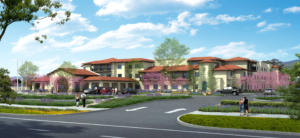 LOS ANGELES—R.D. Olson Development has partnered with Joseph Martelli Real Estate Investments has broken ground on a Residence Inn by Marriott Goleta. The developers are partnering with R.D. Olson sister company R.D. Olson Construction to build the 118-room hotel. Located near Santa Barbara in Silicon Beach South, Goleta has a robust business sector, driven by engineering, software and aerospace industries, according to the developer, making it a perfect site for a hotel development.
“Goleta is a hot bed for engineering, software and aerospace firms due to its quality of life, strategic central coast location adjacent to Santa Barbara, and close proximity to Vandenberg Air Force Base where we will see more private launches take place in the future,” Bob Olson, CEO and founder of R.D. Olson Development, tells GlobeSt.com. “In addition, the University of California Santa Barbara campus located nearby continues to attract world class students and professors and we feel it will continue to be a major driver for visitation to the area. We look to meet the strongest need in market with our new developments and felt upscale extended stay was the gap here.”
The three-story property sits on 3.8 acres on Robin Hill Road and South La Patera Lane in Goleta, and is 80,000 square feet. It features studio, one- and two-bedroom suites, some with full kitchens. This room mix will allow both short-term leisure guests and business travelers to utilize the property. Additionally, there will be 1,300 square feet of meeting space and an outdoor pool and spa, landscaped patio with a fire pit, large fitness center with CrossFit style equipment, a business center and a guest laundry.
The extended-stay property will target both business and leisure travelers in the market. “We have tried to perfect a timeless design for this hotel that pays homage to the rich culture and history of the area and we have incorporated a meditation and display garden to pay respect to the original inhabitants of this land the Chumash Indian Tribe,” adds Olson. “We want this hotel to age with grace and be a relevant and functional property 50 years from now. This hotel will also have great amenities including a resort style backyard pool and spa, putting green, and a giant chessboard in the lawn for anyone to enjoy.”
R.D. Olson has broken ground on the project and aims to deliver it to the market in late 2017. This is a long-term investment for the firm. “We built it with the expectation that we will own it forever,” says Olson. “We spent a lot of time in the details trying to get everything just right and we are excited to see the community and visitors experience the hotel. One of the payoffs for all of the hard work getting a hotel developed is seeing customers use it. We can’t wait to open this beautiful hotel in the second half of 2017.”
LOS ANGELES—R.D. Olson Development has partnered with Joseph Martelli Real Estate Investments has broken ground on a Residence Inn by Marriott Goleta. The developers are partnering with R.D. Olson sister company R.D. Olson Construction to build the 118-room hotel. Located near Santa Barbara in Silicon Beach South, Goleta has a robust business sector, driven by engineering, software and aerospace industries, according to the developer, making it a perfect site for a hotel development.
“Goleta is a hot bed for engineering, software and aerospace firms due to its quality of life, strategic central coast location adjacent to Santa Barbara, and close proximity to Vandenberg Air Force Base where we will see more private launches take place in the future,” Bob Olson, CEO and founder of R.D. Olson Development, tells GlobeSt.com. “In addition, the University of California Santa Barbara campus located nearby continues to attract world class students and professors and we feel it will continue to be a major driver for visitation to the area. We look to meet the strongest need in market with our new developments and felt upscale extended stay was the gap here.”
The three-story property sits on 3.8 acres on Robin Hill Road and South La Patera Lane in Goleta, and is 80,000 square feet. It features studio, one- and two-bedroom suites, some with full kitchens. This room mix will allow both short-term leisure guests and business travelers to utilize the property. Additionally, there will be 1,300 square feet of meeting space and an outdoor pool and spa, landscaped patio with a fire pit, large fitness center with CrossFit style equipment, a business center and a guest laundry.
The extended-stay property will target both business and leisure travelers in the market. “We have tried to perfect a timeless design for this hotel that pays homage to the rich culture and history of the area and we have incorporated a meditation and display garden to pay respect to the original inhabitants of this land the Chumash Indian Tribe,” adds Olson. “We want this hotel to age with grace and be a relevant and functional property 50 years from now. This hotel will also have great amenities including a resort style backyard pool and spa, putting green, and a giant chessboard in the lawn for anyone to enjoy.”
R.D. Olson has broken ground on the project and aims to deliver it to the market in late 2017. This is a long-term investment for the firm. “We built it with the expectation that we will own it forever,” says Olson. “We spent a lot of time in the details trying to get everything just right and we are excited to see the community and visitors experience the hotel. One of the payoffs for all of the hard work getting a hotel developed is seeing customers use it. We can’t wait to open this beautiful hotel in the second half of 2017.”R.D. Olson moves up another spot to #11 on the OCBJ Top Commercial Construction Companies List
June 13, 2016
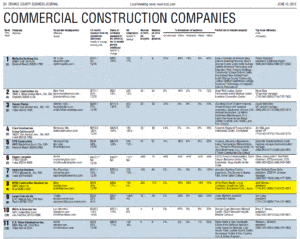 R.D. Olson Construction inches their way up another spot this year to #11 on the Orange County Top Commercial Construction Companies list, but we definitely have the #1 team! We are thoroughly excited that our company continues to grow and look forward to another year of success.
R.D. Olson Construction inches their way up another spot this year to #11 on the Orange County Top Commercial Construction Companies list, but we definitely have the #1 team! We are thoroughly excited that our company continues to grow and look forward to another year of success.
R.D. Olson Once Again on the Top 400 US Contractors List
May 19, 2016 – Engineering News Record
 Irvine, CA – Thanks to our staff's continued dedication to excellence, we were able to get on the ENR (Engineering News-Record) Top 400 Contractors List in the United States. This award is a great measure of the success R.D. Olson has seen in the last few years and exemplifies the organization’s continuous pursuit of top notch service and quality projects in the hospitality, restaurant, multi-family, retail and entertainment sectors. We charted at #302 up from last year's #374 position and we know 2017 can only bring bigger and greater success. You can view the complete list of contractors here.
Irvine, CA – Thanks to our staff's continued dedication to excellence, we were able to get on the ENR (Engineering News-Record) Top 400 Contractors List in the United States. This award is a great measure of the success R.D. Olson has seen in the last few years and exemplifies the organization’s continuous pursuit of top notch service and quality projects in the hospitality, restaurant, multi-family, retail and entertainment sectors. We charted at #302 up from last year's #374 position and we know 2017 can only bring bigger and greater success. You can view the complete list of contractors here.Bicycle Casino Highlighted in Lodging Magazine
April 5, 2016 – Lodging Magazine - April 2016
